Explore These World War I Trenches and Tunnels in France and Belgium
These four sites give visitors a glimpse into the trench warfare tactics soldiers experienced during the Great War
Jennifer Nalewicki
Travel Correspondent
:focal(585x471:586x472)/https://tf-cmsv2-smithsonianmag-media.s3.amazonaws.com/filer/67/3d/673d376c-fb1e-4c24-8266-c59ef5fc95dc/istock-533838141.jpg)
For troops serving on the front lines during World War I, trench warfare was common practice. The use of machine guns and rapid-fire field artillery pieces forced soldiers on both sides, the Allies and the Central Powers, to bore intricate trench systems into the ground. These trenches served as protection against enemy fire and allowed soldiers to fire back without being fully exposed. Tunnels, on the other hand, were used to surreptitiously place explosives beneath unsuspecting enemy soldiers and move supplies between different parts of a battleground. In one known instance, a tunnel was used as an underground hospital.
While overgrowth and erosion have largely overtaken many battlegrounds in the 100 years since the Treaty of Versailles was signed, officially ending the war between Germany and the Allies, archaeologists, historians and even civilians have uncovered the remnants of these protective hideaways throughout Europe. These sites are important glimpses, even today, into battles that took place during the Great War.
Here are four tunnels and trenches visitors can see firsthand:

Canadian Memorial, Vimy, France
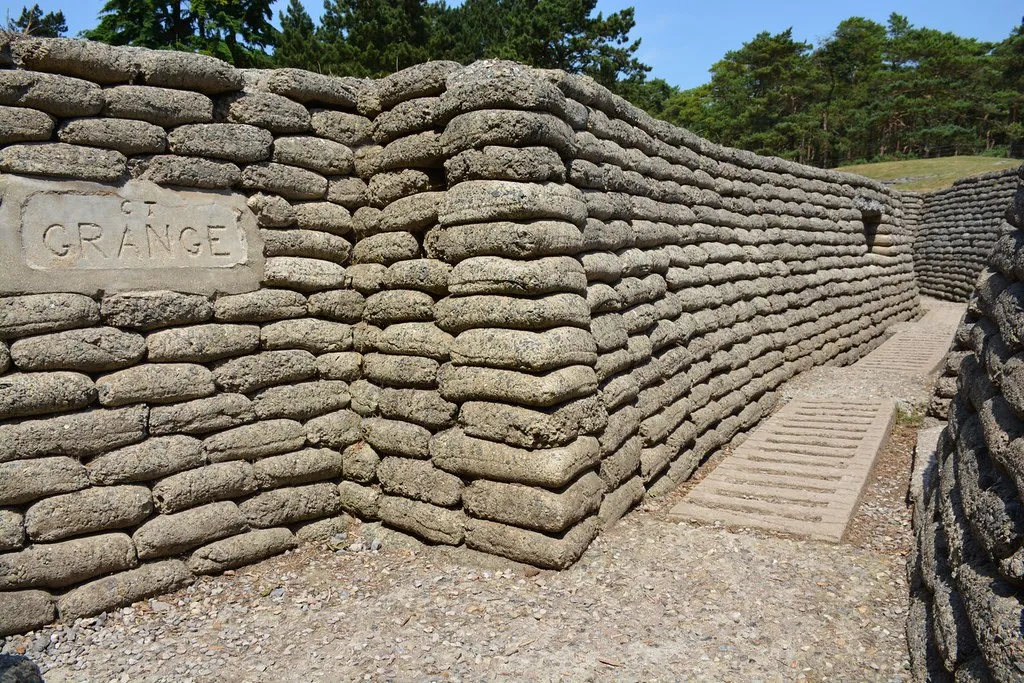
One of the first things visitors notice at this memorial site in northern France, about 125 miles north of Paris, is the massive limestone monument that commemorates the thousands of Canadian soldiers who went missing or were presumed dead during the First World War. The memorial sits on the site of the Battle of Vimy Ridge overlooking the restored remnants of an elaborate system of brick-lined trenches and tunnels burrowed in the surrounding green hills.
In preparation for the battle, the Canadian Armed Forces worked with several British tunneling companies to create an intricate underground network of tunnels, some nearly a kilometer in length to protect soldiers and to facilitate and disguise the movement of troops and supplies. This was particularly important as the Germans held the higher ground in the region and could easily spot activity on the surface. Some tunnels were outfitted with running water and lighting systems. Others were used to covertly position explosives beneath German fortifications.
On the morning of Easter Sunday, April 9, 1917, during a sleet storm, the Canadian Armed Forces attacked the German Sixth Army. Waves of Canadian troops poured over the trench walls following close behind an artillery attack designed to give the Canadians time to reach the German positions before the Sixth Army could recover from the barrage. Despite heavy losses, the Canadians succeeded in driving the Germans back.
Today, tour groups can explore both the tunnels and trenches with guides, or virtually via Google Canada .
Wellington Quarry, Arras, France
/https://tf-cmsv2-smithsonianmag-media.s3.amazonaws.com/filer/10/9b/109b5136-8e11-403c-94ba-75c9884c0e23/5088907181_a3fbb80f30_b.jpg)
The tunnels associated with the Wellington Quarry , or la Carrière Wellington, located 110 miles north of Paris, were so elaborate that they contained a working hospital for the British Army and Allied Powers fully equipped with 700 beds and operating theaters. Not only that, but workers from the New Zealand Tunneling Company—tapped to complete the massive project—built the labyrinth of passageways so that they interlinked with preexisting tunnels dating back to the Middle Ages. (The name Wellington is a nod to New Zealand's capital city.) Today, the Carrière Wellington Museum resides underground, and tours include an elevator ride 70 feet below the surface, a description of the 1917 Battle of Arras that happened here between the British Empire and German Empire, and a glimpse at soldiers’ subterranean lives by visiting their sleeping quarters and the hospital for wounded soldiers.
Sanctuary Wood, Ypres, Belgium
/https://tf-cmsv2-smithsonianmag-media.s3.amazonaws.com/filer/40/4f/404f36f7-f524-4cf4-8451-d420048f9554/istock-174939198.jpg)
Once the dust settled after the final battle of World War I and citizens received the all clear, one farmer by the name of Schier returned to reclaim his property and discovered a maze of trenches bored into his land in western Belgium. Rather than replant his crops, he decided to keep the land as it was to preserve the memory of the Great War and those who lost their lives in battle. In the century since, the property remains in the hands of the same family, the Schiers, who maintain it and have kept it largely the way it appeared when their late relative discovered it. Today, Sanctuary Wood serves as a museum filled with artifacts discovered onsite, including weapons, ammunition, gravesites, soldiers’ personal belongings and photos. But arguably the main feature is the series of zigzagging, corrugated metal-lined trenches that stand as a reminder of where the British front line once resided and where hundreds of men lost their lives.
Beaumont-Hamel Newfoundland Memorial, Beaumont-Hamel, France
/https://tf-cmsv2-smithsonianmag-media.s3.amazonaws.com/filer/d7/3c/d73c1961-0f97-4ba8-bb9b-e144c9f5370d/beaumont-hamel_tranchees_3.jpg)
Among the trenches that make up this network constructed in a pocket of northern France, located about 100 miles southwest of Belgium, are some of the most shallow built during the war. In the years since, they have been taken back by nature. The undulating hills and valleys appear, on first glance, to be a mere quirk of the landscape, but in reality they served as protection for the Allied Powers. Today, the 74-acre site is home to a memorial —a bronze caribou atop a granite pyramid—commemorating soldiers of the Canadian Armed Forces, in particular those from Newfoundland who bravely served their country.
Get the latest Travel & Culture stories in your inbox.
Jennifer Nalewicki | | READ MORE
Jennifer Nalewicki is a Brooklyn-based journalist. Her articles have been published in The New York Times , Scientific American , Popular Mechanics , United Hemispheres and more. You can find more of her work at her website .

Sign Up Today
Start your 14 day free trial today

The History Hit Miscellany of Facts, Figures and Fascinating Finds
Explore the History of the Western Front: 10 World War One Battlefield Sites in Europe
Discover the history of world war one at these historic battlefields, memorials and monuments in belgium and france..

Harry Sherrin
09 nov 2021.
In the early days of World War One , the German Army advanced into Belgium and Luxembourg, creating the Western Front – a 400-mile-long stretch of land from France’s Swiss border to the North Sea that would go on to host some of the most brutal theatres of conflict in World War One, if not all of history.
Characterised by trench warfare, in which pockets of land were fought over for weeks and months in horrific conditions, the battlefields of World War One witnessed a devastating loss of life.
More than a century later, the devastation of World War One can still be seen in the landscapes, museums and memorials of northern France and Belgium.
From the subterranean hospital of Wellington Quarry to the infamous battleground of Passchendaele , here are 10 World War One battle sites to visit along the former Western Front.

1. Passchendaele, Belgium
The Third Battle of Ypres , later known as Passchendaele, was the site of a major British and French advance in 1917. It gained infamy for its mud and for the tragic loss of life suffered on both sides: the British alone lost some 300,000 soldiers at Passchendaele, and more than 250,000 Germans are also thought to have died.
Today, the battlefields of Passchendaele can be visited solo or as part of guided tours. Many operators offer tours around the wider region of the Ypres Salient – also referred to as Flanders Fields. The area is also home to some key museums and monuments, including the Memorial Museum Passchendaele, the 85th Canadian Memorial and the Passchendaele New British Cemetery.

2. Sanctuary Wood, Belgium
After the close of World War One , a farmer returned to his land in western Belgium to find a network of trenches and tunnels carved through it. His property, now known as Sanctuary Wood, had been the site of intense fighting during the war. Instead of reworking the earth back into shape, he preserved the area’s military relics for visitors.
Visitors to Sanctuary Wood today can explore the trenches and tunnels of this former battleground. Now a comprehensive museum, filled with recovered soldiers’ possessions, weaponry, ammunition and much more, Sanctuary Wood makes for an immersive and moving experience.

3. Vimy Ridge, France
The Battle of Vimy Ridge was part of the larger Battle of Arras during World War One. On 9 April 1917, Easter Monday, Canadians forces attacked German positions on Vimy Ridge, northern France. After 4 days of fighting, and suffering more than 10,000 casualties, the Canadians seized the region.
Today, Vimy Ridge hosts a vast stone monument to the Canadian soldiers who died during the attack. Visitors to the area can also take a guided tour through Vimy Ridge’s network of restored trenches and tunnels that were first carved into the hills during World War One.

4. Wellington Quarry, France
The Wellington Quarry was a subterranean labyrinth of tunnels dug into the earth of northern France during World War One . The underground site was vast, encompassing newly dug routes and rooms as well as existing medieval tunnels. Built by the New Zealand Tunneling Company, the quarry ultimately contained a fully functioning hospital of some 700 beds.
Today, the tunnel system is home to the Carrière Wellington Museum. Visitors to the site can expect to take an elevator deep underground, where they’ll be immersed in the history of the former military hospital and subterranean stronghold.

5. Circuit of Remembrance, France
The Battle of the Somme began on 1 July 1916 and lasted nearly 5 months. It was one of the largest battles of World War One and among the bloodiest in human history. On the first day of battle alone, Britain lost nearly 60,000 men, making it the deadliest day in British military history . And by the close of the Battle of the Somme, a million soldiers from either side had died.
Today, a 40-mile route known as the Circuit of Remembrance starts from either the town of Albert or that of Peronne, winding through numerous battle sites, memorials and museums in the region. Those who wish to embark on this route of Somme battlefields can download audio guides to the route for free from various online sources – including the website of the Historial de la Grande Guerre Museum. Alternatively, various operators offer guided tours around the region.

6. Pozieres, France
Pozieres was the site of a major battle between Allied and German forces in 1916. Launched on 23 July, it saw Australian forces battle for the town of Pozieres, which would allow the Allies to attack the German stronghold of Thiepval.
Today, visitors can discover the history of the battle through signs and information panels at the site of the Battle of Pozieres. The area is also home to a Tank Memorial and the remnants of the Gibraltar blockhouse which served a German observation tower. There is also a cemetery and several obelisk-shaped memorials. Pozieres is one of the sites that make up the Circuit of Remembrance.

7. Lochnagar Crater, France
The Lochnagar Crater, located in the village of La Boisselle in France’s Picardie region, is the site where one of the first and largest explosions of the Battle of the Somme took place on 1 July 1916.
Set off by British forces at 7:28 am, the mine which created the Lochnagar Crater was one of the biggest ever detonated at that time in history. The crater itself is an astounding 100 metres in diameter and 30 metres deep. Today, visitors can see Lochnagar Crater either as a one-off site or as part of the Circuit of Remembrance.

8. Ulster Memorial Tower, France
The Ulster Memorial Tower in Thiepval in France is a 70-foot-high stone structure built as a memorial to the men of Ulster who fought and gave their lives during World War One. The first memorial to be built on the Western Front, the Ulster Memorial is a replica of Helen’s Tower, an important monument which is located in County Down in Northern Ireland.
Located on what was the German front line during the Battle of the Somme, the memorial faces Thiepval Wood, the site from which the 36th (Ulster) Division made its charge on the first day of the famous offensive, 1 July 1916. Today, the site offers guided tours of these woods from its visitor centre. Inside, visitors can view the plaques dedicated to the Irish soldiers, several paintings and visit its memorial chapel.

9. Verdun Memorial Museum, France
For those wishing to tour the battlefields of Verdun, the Verdun Memorial Museum offers advice and itineraries, meaning it’s a good starting point for anyone visiting the region.
The Verdun Memorial Museum is dedicated to the soldiers who lost their lives at the Battle of Verdun (21 February to 18 December 1916). It stands near the site of the lengthy battle, and the surrounding landscape bears the scars of the war, including mine and shell craters. On display at the memorial museum are weaponry, French and German aircraft, photographs and medical equipment.
Laid out over two floors, the Verdun Memorial Museum immerses the visitor in the realities of the battle by recreating the trench system and using multimedia presentations to guide visitors through the events of the war. Exhibits are translated into English, French, German, Italian, Spanish and Dutch.

10. Fort Douaumont, France
Fort Douaumont was one of the strongest, most state-of-the-art forts in France at the time of World War One. But in 1916, the stronghold was destroyed during the Battle of Verdun. Today, it stands as a ruin, a haunting reminder of the devastation of World War One .
Fort Douaumont still appears almost exactly as it did at the end of World War One. Despite the destruction, parts of Fort Douaumont are well preserved, including the barrack rooms and command posts. Visitors can take a tour through its 3 levels and see the guns, turrets and weaponry which remain. There is also a graveyard.


France’s Western Front & Champagne WWI Sites Travel Itinerary

Visit Verdun, Metz, Champagne, battlefields and memorials with France’s Western Front WWI Sites Travel Itinerary from PBS host Darley Newman.
This itinerary takes travelers to significant WWI sites located throughout Northeastern France along the historic Western Front to learn about the history of The Great War. Many of the sites I’m highlighting are of special importance to Americans like Verdun, Compiegne, Aisne-Marne American Cemetery and more.
We followed the below itinerary to film two half hour episodes on “ France’s Western Front ,” broadcasting now on PBS and Amazon Prime. While we visited battlefields, memorial sites and museums, we also visited great Champagne cellars, lively markets, took a cooking class, and walked historic cities—all things you may want to experience as you delve into history and culture in Northeastern France.

Background on France’s Western Front and the Centenary of WWI From August 1914 until November of 1918 Northeastern France was a war zone and though today travelers may find small villages, pretty countryside and great cuisine, the scars of the past are visible in the form of destroyed villages, large memorial sites, and through the local people, who continue to commemorate The Great War. We timed our travels and filming for our PBS episodes along the Western Front with the Centenary of WWI, which started in 2014 with commemorations of the outbreak of the war and will continue until 2018.
Day 1- Compiegne and the Armistice Memorial Museum at Rethondes
Most flights arrive to Paris in the morning. We flew Air France and then rented a vehicle for our crew and equipment and traveled to the Oise area. While we liked the freedom of driving, one might also take the train to many sites listed in this itinerary and could also consider combining the train with hiring private guides.
Our first stop was lovely Compiegne, just a 90-minute drive from Pairs and a spot where café culture reigns supreme. I was lucky on my visit to find an ice cream truck in the town square serving ice cream topped with Chantilly Cream, a traditional French cream that hails from this region.

Compiegne is a nice place to relax in the midday sun and pay tribute to Joan of Arc, who hid out in the nearby Compiegne woods before her capture in 1430. You’ll find a statue dedicated to Joan of Arc in the main square. Consider having lunch in Compiègne at charming and award-winning L’endroit.
Compiegne’s nearby woods would be the site of important diplomatic events centuries later and today are home to the Armistice Memorial Museum at Rethondes where on November 11th, 1918 the Germans signed the Armistice to end the war. The site has memorials where you can pay tribute to the tens of millions of men who fought in WWI, one of the deadliest conflicts in human history.
Step inside the Armistice Memorial Museum at Rethondes, where you’ll find a replica of the original train car where Marshal Foch met with the Germans to sign the Armistice to end World War I. This same railroad car would be significant during the Second World War, when Hitler ordered that it be returned to the same location, forcing the French to sign their surrender to the Nazis on June 22, 1940.
Spend the next few nights at Hôtel du Golf de l’Ailette in Chamouille . Enjoy dinner at the hotel, which overlooks a pond, where you may find swans gliding about.

Day 2- Château de Blérancourt, Belleau Wood, Aisne-Marne American Cemetery & Champagne
Today focuses on The Great War through the eyes of an American woman who for more than eight years worked to help rebuild Northern France at Château de Blérancourt. The daughter of wealthy American financier J.P. Morgan, Anne Morgan founded the American Committee for Devastated France, a group of 350 American women volunteers who delivered medical and social services, based at Château de Blérancourt, a 17th century chateau approximately 40 miles form the front lines. At a time when most women in France and America didn’t even have driver’s licenses, Anne Morgan drove supplies through combat zones.
Château of Blérancourt is an elegant seventeenth-century château. It now houses a French national museum on Franco-American Cooperation with a unique collection highlighting the activities of Anne Morgan’s American Committee for Devastated France; the first American ‘fly boys’, the Lafayette Flying Corps; an exhibit on volunteer ambulance drivers, especially those of the American Field Service and more.

On site, enjoy lunch at The Hostellerie Le Griffon at Blérancourt, which has a nice view of the chateau and good food. If you’d like something sweet after lunch, walk from the chateau into town to visit Artisan Boulanger to get a chocolate éclair and other tasty pastries.
This afternoon, visit Bois Belleau and Cote 204 monument. On the very spot where this cemetery was built, the Americans stopped Germans thrust during the summer of 1918. With over 2,000 graves and its commemorative chapel, Belleau Wood has been converted into a memorial dedicated to all Americans who fought there during the First World War. Today the wood itself remains a shrine, where some artillery weapons are a grim reminder of the violent fights which took place there.
Over the course of several weeks in June 1918, Americans, including those from the 4th Marine Brigade of the US Army’s Second Division, fought one of WWI’s most brutal battles, the Battle of Belleau Wood. It would result in over 8000 American casualties with many of those American men who fought at Belleau Wood and in the vicinity buried today at the Aisne-Marne American Cemetery. The cemetery contains the headstones of soldiers, sailors, marines, aviators, who died not only during these battles but from June 1918 all the way to the end of the war.
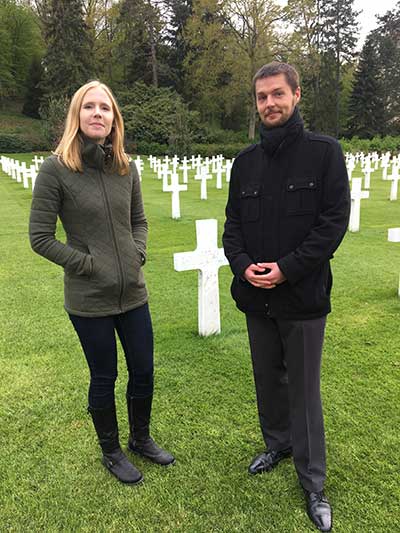
Just down the road, the majestic Château-Thierry American Monument overlooks the Marne valley. It honors he American soldiers who fought in the region. It’s also en route to Chateau-Thierry, our next stop.
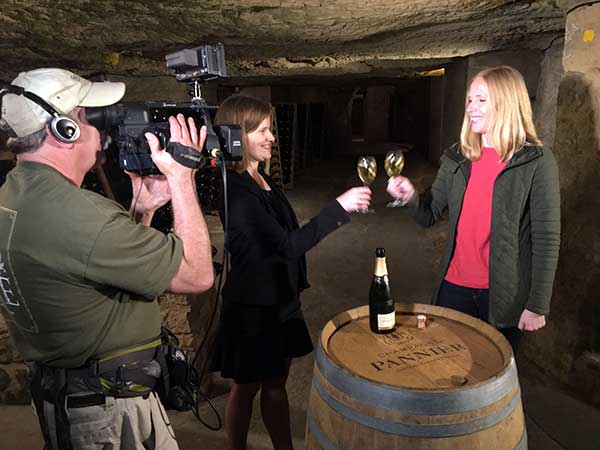
Mix history with Champagne this afternoon at Champagne Pannier’s cellars at Château-Thierry. Within these medieval cellars in the heart of the Marne Valley vineyard, solders and local residents hid out during the war. The historic Champagne region has been the site of many battles over the centuries, including during the First World War. Cellars like this one, which are a safe haven for Champagne today were once battle sites and hiding places, too.
Day 3- Caverne du Dragon, Chemin des Dames & Reims
Another scene of lengthy fighting is in Aisne along the Chemin des Dames, a strategic plateau where around 200 underground quarries would be used by soldiers during World War I. Along the Chemin des Dames, there are various gravesites, destroyed villages and quarries, like the Caverne du Dragon, which became army barracks during the Great War and the site of an epic underground battle in 1917 between French and German troops.. Travelers can take a guided tour, following in the footsteps of soldiers. The chapel, first aid station, command post and No Man’s Land movingly testify to the lives of these men – both French and German – who fought and lived, sometimes even side by side, in the obscurity of these underground spaces.
From the very first clashes right to the end of the war, the Chemin des Dames was a frontline position where violent fighting took place, particularly during the Nivelle Offensive on April 16, 1917. Along a trail of 18.6 miles, many sites will enable you to discover and understand the history of this significant area of remembrance. Two places that cannot be missed are the Plateau de Californie and the former village of Craonne.
Travel onwards to the Marne to historic Reims, less than an hour and a half drive. Enjoy lunch in Reims with a culinary workshop next to the Reims Cathedral at Au Piano des Chefs with Chef and Entrepreneur Eric Geoffroy.
Geoffroy’s emphasis is on creating memorable cooking experiences that are educational, interactive and fun, using seasonal and local produce and showcasing local and regional producers. Workshops can be tailored to individuals or small groups, private or corporate.

After your cooking adventure, enjoy a guided visit at the Taittinger House of Champagne. Taittinger has cellars dating back to the 4th century and over time these cellars played a role in profound events, including The Great War. Graffiti tells the story of the cellars use as a refuge for soldiers, children and more.
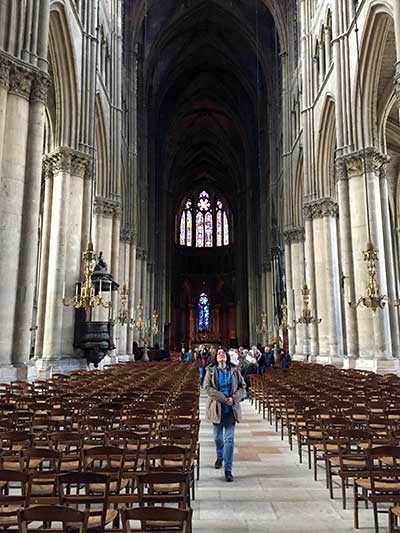
While in Reims, travelers must visit the Reims Cathedral. During The Great War, the front line was just outside of the city and much of Reims was destroyed by German shelling. The cathedral was not spared, being hit by hundreds of shells and at one point catching fire. The walls and buttresses survived, but the rest was devastated. Restoration work began in 1919 with hefty later donations from the Rockefeller Family. Today the cathedral welcomes travelers from around the world, who are greeted by the Cathedral’s Smiling Angel.
Spend tonight in Reims at Hôtel de la Paix in Reims, which is located right downtown. You can walk to tonight’s dinner location, L’Alambic. The atmosphere in L’Alambic in Reims is designed to look like Champagne cellars, making for a fun dining adventure.
Day 4- Champagne and Argonne
Visit ‘La Main de Massiges,’ the Hand of Massiges a high point where the Germans retreated in 1914. It’s here that the Champagne and Argonne fronts meet. Though the Champagne area of France has soil well suited for growing grapes for Champagne, this chalky soil, when dug out to build trenches, floods easily, making for impossible conditions. The trenches have been restored to appear as they would have in 1914 and 1915, when the majority of the fighting was going on in this strategic location near the Argonne front and the Champagne front. Walking through gives a further chilling sense of life on the front lines.
From here, it’s a scenic 45 minute drive to the Meuse area. Make a stop at one of the most interesting WWI related destinations on this itinerary, the Romagne 14-18 museum. Owner Jean-Paul de Vries’ started collecting WWI artifacts when he was just seven years old and has gone on to amass over 80,000 objects. This museum reveals what daily life was like for the average soldier through objects with their own personal story.
With its over 14,000 crosses, the Meuse-Argonne American Cemetery and Memorial is the largest American graveyard in Europe. The Sammies who fell during the battle to liberate the Meuse-Argonne area rest in peace here. Its layout and architecture make this an essential part of any tour aiming to show what Americans mean when they say, “We shall never forget”.
Soldiers from across the United States courageously fought and died in the Meuse-Argonne Offensive, like Erwin Bleckley from Kansas, who received the Congressional Medal of Honor for his service. The visit particularly hit home for me upon seeing the headstone of Freddie Stowers from my home state of South Carolina. The grandson of a slave who was drafted into the Army in 1917, Stowers was recommended for the Medal of Honor after his death. He wasn’t honored with it until decades later in 1991. Stowers is one of only two African American men to receive the medal of honor from WWI, though many more surely deserved it.
It’s not just the seemingly endless headstones that lay witness to the dead, the Memorial chapel, contains the names of servicemen and women who went missing from the area during the war, including those from the U.S. expedition to northern Russia. Rosettes mark the names of those since recovered and identified.
Also, consider visiting the American Monument at Montfaucon-d’Argonne. This monument was erected by the American Battle Monuments Commission (ABMC), a US government agency that also takes care of its maintenance. Visitors can climb to the observation platform (opening times are displayed outside) from where they can enjoy a magnificent view over almost all of the territory conquered during the Meuse-Argonne offensive.
Drive onwards, about 40 minutes, to Verdun and spend tonight at Les Jardins du Mess in Verdun , where we also recommend having dinner.
Day 5- Verdun
The Meuse is home to a wide range of unique local gastronomic pleasures. Verdun is the world capital of the “Dragée.” This delicate candy is a sugar coated almond was considered an aid to fertility and today, no self respecting wedding or baptism celebration would be without “dragées” on the table. A visit to the Braquier Dragée Factory in Verdun will hold many pleasant surprises. Braquier’s sweet dragees have been held in high regard through the centuries with past clients including the King of England, Prince of Wales and President Charles de Gaulle. Travelers can take a guided tour.
Enjoy lunch at Chez Mamie. If it’s on the menu when you visit, as the menu does change with the seasons, order the white asparagus and quiche Lorraine. The quiche Lorraine here is truly authentic, made without cheese. Yes, here in Lorraine, France the real deal is made with flour, butter, salt, eggs that are well whipped, double cream and bacon and it’s good.
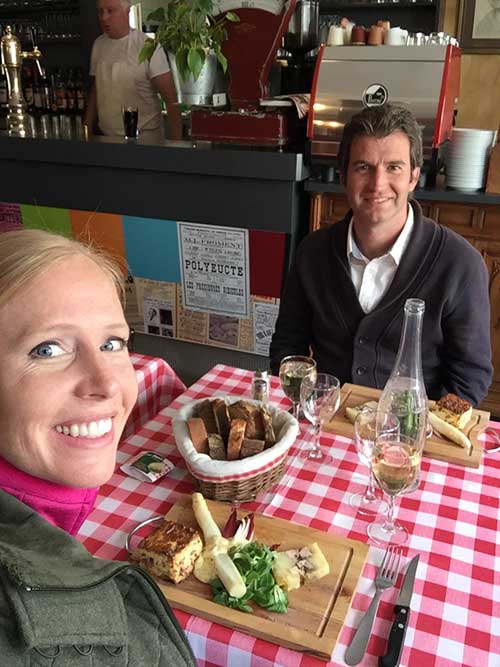
Definitely try quiche Lorraine in Lorraine. We had a wonderful meal including white asparagus at Chez Mamie in Verdun.
This afternoon, visit Verdun Battlefield. There are a variety of ways to explore. We chose to ride bikes, but you can also ride horses, walk or drive. Sites are some distance apart.
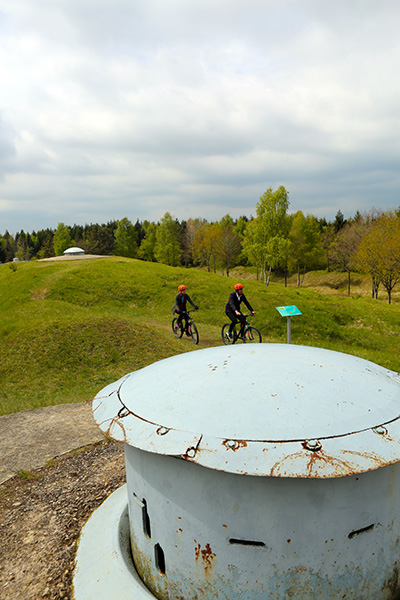
A visit to the Verdun Battlefield is an essential step in understanding the intensity of the fighting, the life of the solders and the artillery duel that marked the Great War. Verdun, the largest city in Meuse, was also the site of the longest battle of World War I, the Battle of Verdun.
300 days and 300 nights of unbroken fighting took place at Verdun. The Battle of Verdun in 1916 was the most deadly head-on clash between France and Germany in history. The struggle to totally destroy men and defenses by means of an unprecedented artillery battle symbolizes and summarizes industrial warfare.
Verdun’s cemetery lays heavy with visible gravesites, while the ossuary is home to the remains of 130,000 unknown soldiers. These are important to visit, but we also recommend Fort Douaumont, the largest fort built around the town. Travelers can go inside.
In the heart of the Battlefield, the Verdun Memorial, which first opened in 1967 under the patronage of French Academician and war veteran Maurice Genevoix, is one of the most important Great War museums in Europe. It is also one of the only museums built on the actual site of a battle.
Stay tonight at a French Chateau just south of Verdun. Chateau des Monthairons was used as a hospital for American troops and a base for ambulance sections during The Great War and during World War II was occupied by German troops. Today this historic chateaux is a pet friendly and regal place to stay. We recommend eating dinner here. Their cheese board is truly impressive!
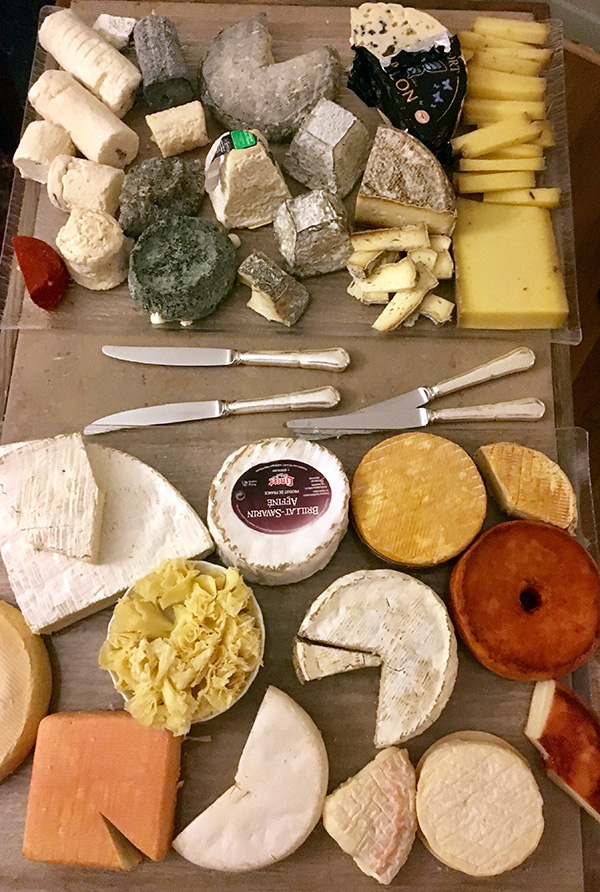
Day 6- Metz
Drive through the Meuse Hills to Metz, located just an hour from Luxembourg. A rural and peaceful route today, the effects of WWI are ever present. Villages have statues to commemorate the fallen soldiers, located in front of pretty town halls.

To stretch your legs, I recommend a stop in Saint Mihiel, the site of a landmark World War I battle, the Battle of Saint Mihiel. It was the first independent American offensive of the war and the single largest American military undertaking up to that point. In September 1918 half a million US troops and over 100,000 men from the French Army banded together to take back territory that had been under German control for four years. Surprising the Germans with a short artillery bombardment and then by navigating over barbed wire, thought to be impassible, the battle was won and the term D-Day was born with the Battle of Saint Mihiel.
Saint Mihiel today is worth a stop and if you do, make sure to visit a local pastry shop. We stopped at Rochers Et Croquets, which is divine. Macarons may help fuel the rest of your drive to Metz, where more good food and history await.

The history of Metz dates back over 3000 years and the various historical periods are reflected in the architecture, making walking around a treat. The mix of lively shopping streets and riverside walks makes Metz ideal for pedestrians and cyclists. Family-friendly parks and gardens abound. See the swans on the river Moselle or the eco-gardens along the river Seille, or just enjoy a stroll along the old ramparts from the Germans Gateway to the Cathedral. Metz, with its well preserved buildings, is a classed “City of Art and Heritage”.
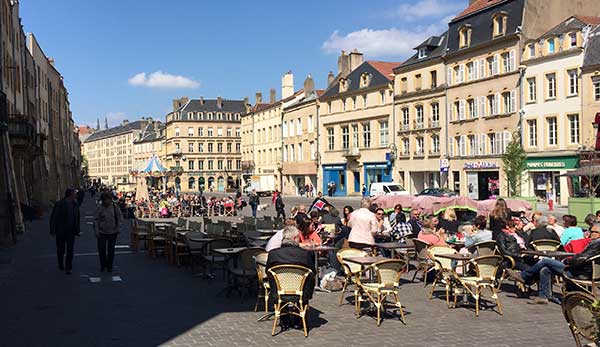
One of the oldest markets in France, the Metz Covered Market is located in the city center beside the historic Roman Catholic Cathedral. Like many buildings in Metz, the covered market has an interesting story. Inside, it’s a true adventure for food lovers.
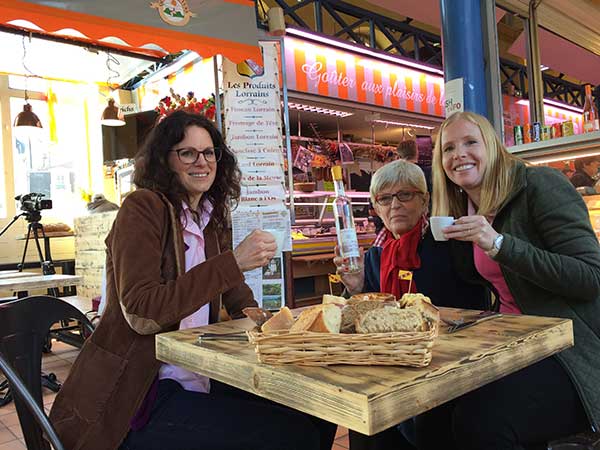
In the Metz Covered Market, stop by Chez Mauricette, for quiche Lorraine and Mirabelle plum liqueur.
Stay tonight at Hotel Restaurant Mercure Metz Centre , which is conveniently located within walking distance of the Covered Market and the rest of Metz and has a restaurant onsite.
The above itinerary may take you longer to complete yourself. You may like to spend more time at each. Please use this as an overall guide for things to see and do. For more information on visiting these areas, check out the websites for Oise Tourisme, Aisne Tourisme, Meuse Tourisme, Champagne Ardenne, Lorraine Tourisme and the France Tourism WWI Centennial site.
Interested in learning more? Check out a preview for the “Travels with Darley: France’s Western Front” episodes broadcasting now on PBS stations across the nation and watch these full episodes on Amazon Prime .
Post navigation
Previous post.

No comments yet. Why don’t you start the discussion?
Leave a Reply Cancel reply
You must be logged in to post a comment.
- History Classics
- Your Profile
- Find History on Facebook (Opens in a new window)
- Find History on Twitter (Opens in a new window)
- Find History on YouTube (Opens in a new window)
- Find History on Instagram (Opens in a new window)
- Find History on TikTok (Opens in a new window)
- This Day In History
- History Podcasts
- History Vault
Life in the Trenches of World War I
By: Brian Dunleavy
Updated: April 26, 2021 | Original: April 23, 2018

When Union Army General William Tecumseh Sherman famously said “War is hell,” he was referring to war in general, but he could have been describing trench warfare, a military tactic that’s been traced to the Civil War . Trenches—long, deep ditches dug as protective defenses—are most often associated with World War I , and the results of trench warfare in that conflict were hellish indeed.
Trenches were common throughout the Western Front.
Trench warfare in World War I was employed primarily on the Western Front, an area of northern France and Belgium that saw combat between German troops and Allied forces from France, Great Britain and, later, the United States.
Although trenches were hardly new to combat: Prior to the advent of firearms and artillery, they were used as defenses against attack, such as moats surrounding castles. But they became a fundamental part of the strategy with the influx of modern weapons of war.
Long, narrow trenches dug into the ground at the front, usually by the infantry soldiers who would occupy them for weeks at a time, were designed to protect World War I troops from machine-gun fire and artillery attacks from the air.
As the “Great War” also saw the wide use of chemical warfare and poison gas, the trenches were thought to offer some degree of protection against exposure. (While significant exposure to militarized chemicals such as mustard gas would result in almost certain death, many of the gases used in World War I were still relatively weak.)
Thus, trenches may have afforded some protection by allowing soldiers more time to take other defensive steps, such as putting on gas masks.
Trench warfare caused enormous numbers of casualties.
At least initially in World War I, forces mounted attacks from the trenches, with bayonets fixed to their rifles, by climbing over the top edge into what was known as “no man’s land,” the area between opposing forces, usually in a single, straight line and under a barrage of gunfire.
Not surprisingly, this approach was rarely effective and often led to mass casualties.
Later in the war, forces began mounting attacks from the trenches at night, usually with the support of covering artillery fire. The Germans soon became known for effectively mounting nighttime incursions behind enemy lines, by sending highly trained soldiers to attack the trenches of opposing forces at what they perceived as weak points.
If successful, these soldiers would breach enemy lines and circle around to attack their opponents from the rear, while their comrades would mount a traditional offensive at the front.
The brutality of trench warfare is perhaps best typified by the 1916 Battle of the Somme in France. British troops suffered 60,000 casualties on the first day of fighting alone.

Disease and ‘shell shock’ were rampant in the trenches.
With soldiers fighting in close proximity in the trenches, usually in unsanitary conditions, infectious diseases such as dysentery, cholera and typhoid fever were common and spread rapidly.
Constant exposure to wetness caused trench foot, a painful condition in which dead tissue spread across one or both feet, sometimes requiring amputation. Trench mouth, a type of gum infection, was also problematic and is thought to be associated with the stress of nonstop bombardment.
As they were often effectively trapped in the trenches for long periods of time, under nearly constant bombardment, many soldiers suffered from “ shell shock ,” the debilitating mental illness known today as post-traumatic stress disorder (PTSD).
It’s likely all of these factors, which stemmed from the widespread use of trench warfare, made World War I the deadliest conflict in global history to that point. It’s believed that as many as one in 10 of all fighting forces in the conflict were killed.
It was also the first conflict in world history to have more deaths caused by combat, rather than from disease spread during the fighting.
Trench warfare was also employed in World War II and in the Korean War to some degree, but it has not been used regularly during conflicts in the ensuing decades.

Sign up for Inside History
Get HISTORY’s most fascinating stories delivered to your inbox three times a week.
By submitting your information, you agree to receive emails from HISTORY and A+E Networks. You can opt out at any time. You must be 16 years or older and a resident of the United States.
More details : Privacy Notice | Terms of Use | Contact Us
Self-drive Itineraries & Tours of the WW1 Battlefields
Travellers wishing to tour the battlefields independently by car, motorbike, motorhome or bicycle can do so with help from specific itineraries drawn up by an expert guide to the WW1 battlefields.
The organizations listed here either offer itineraries and route information to download for your self-drive independent travel to the battlefields, or there are companies which will create tour itineraries and arrange accommodation for you.
Any company listed on greatwar.co.uk is offered to help travellers to the battlefields find a tour company or guide to suit specific requirements. You are advised to contact the tour guide or company directly with any enquiry about the tours or itineraries they offer. Where appropriate you should ensure they comply with any travel, package holiday and package tours regulations. Greatwar.co.uk cannot be held responsible for a guide or tour company failing to comply with package holiday travel regulations and public liability cover.
Self-Drive Battlefield Tour Itineraries
Self-drive battlefield tours (paid-for arrangements/itineraries), australian remembrance trail: france and belgium.
Australian visitors may be interested to see a website established by the Australian Government called the ANZAC Portal. It provides information about the major sites to visit in France and Belgium where the Australian forces fought and where they are commemorated.
Website: www.ww1westernfront.gov.au The Australian Remembrance Trail
“Circuit of Remembrance”, Somme Battlefields, France
The Somme “Circuit of Remembrance” (also called The Remembrance Trail) has been set up by the organisation called Somme Battlefields' Partner. It is a route of approximately 40 miles in total with 10 stops at important sites between the towns of Albert and Péronne. This is a route that can be followed if you are visiting the battlefields independently. You can either make the visits yourself or, alternatively, there are local guides who can arrange to take you round (there would be a charge for this option). For information about the “Circuit of Remembrance”, the location of the main historical sites to visit or recommended guides go to 'The Great War: A Chapter in History' page on the official Somme tourism website:
Website: www.somme-battlefields.com The Great War
Digital Guide to Download: Sites of the First World War (Somme)
For a downloadable guide to the Battles of the Somme, a map and descriptions of the main sites to visit go to this link provided by the official Somme tourism website:
Website: fr.calameo.com Sites of the First World War
Road Trip: The Great War and More
This is the first in a new series of itineraries for self-driving tours from Vicarious Media. The tour includes travel visiting historical locations for the First and Second World Wars, taking in five cities across France, Belgium, Germany and the Netherlands. The tour is suitable for motorbikes, cars, motorhomes and campervans.
For more information, testimonials, features, a sample of the guide and how to purchase it visit the Vicarious Media website:
Website: vicarious-shop.com Road Trip: The Great War and More
Battlefields by 4x4
Telephone: 0701 424 1418 (calls charged at premium rate)
Email: [email protected]
Website: www.battlefieldsby4x4.com
Battlefield tours led by experienced battlefield guides and qualified off-road drivers, which are specifically designed for owners of standard four wheel drive vehicles. Commentary by your guides is delivered to your own vehicle and an A5 bound booklet will be given to you with photographs and information about the places you are to visit. Every assistance will be given to lead you through spectacular countryside, including off-road driving, and show you the well-known and not so well-known battlefield sites. Most tours are organized over three days, two and a half days of this consisting of driving time.
Tours are based on either pre-arranged itineraries, or a combination of tour destinations, or on a tour customised to your own requirements. Pre-arranged tour itineraries include:
- The Somme 1916
- The Tank 1917
- D Day 1944 (annual tour in June available from 2015)
- Battlefields of the Aisne, Champagne and Meuse in Eastern France to be announced
For more information, bookings and answers to any questions you may have, visit the website:
Galina Battlefield Tours
Official Tour Operators to the Normandy Veterans Association; Member of ABTA No. Y4466
Address: Galina International Battlefield Tours, 16 Bridge Street Row, Chester, CH1 1NQ
Telephone: 01244 340 777
Email: [email protected]
Website: www.wartours.com
Galina Battlefield Tours is a well-established battlefield tour company offering quality tours for groups and individuals. Self-drive tour itineraries are also available from Galina. Self-drive tours can be tailored to suit your requirements, your travel dates, accommodation needs, and the places you wish to visit.
For full details and to request a free quotation visit the Self-drive page on the Galina Battlefield Tours website:
Website: www.wartours.com Self-drive
Somme Battlefield Tours Ltd.
Member of the Guild of Battlefield Guides (GBG)
Telephone: +44 (0)1202 - 880 211
Website: www.battlefield-tours.com
A small company which specializes in Self-Drive tours to the Somme and Ypres battlefields.
Related Topics
Visiting the ww1 western front battlefields.
Advice and useful information about travelling, accommodation and tourist information for visitors to the Western Front battlefields:
Visiting WW1 Western Front Battlefields
Battlefields of the Western Front
Pages on the battlefields by area including comprehensive listings and locations of military cemeteries, main memorials, battle remains, museums and accommodation:
The Yser Battlefields & the Belgian Coast
The Ypres Salient, Flanders, Belgium
French Flanders and Artois
The Somme, Picardie, France
Guidebooks for the WW1 Western Front Battlefields
Recommended guidebooks for visitors:
Maps for Travel to the WW1 Battlefields
For recommended modern road, cycling and walking maps on the Western Front battlefields, see our page:
Apps for the WW1 Battlefield Visitor
Somme Battlefields' Partner, France
The Somme Battlefields' Partner is a network, where local professionals involved in tourism and the history of the Somme battlefield area have come together. Information about the Somme Battlefields' Partner is on the official Somme tourism website at:
Website: www.somme-battlefields.com Somme Battlefields' Partner
Battlefield Tours
Battlefield Tours & Travel
Battlefield Tour Companies and Guides (from the United Kingdom)
Battlefield Tour Companies and Guides based in Belgium and France
Cycling Routes & Tours on the WW1 Battlefields
Walking the WW1 Battlefields
Motorcycling Tours on the WW1 Battlefields
Battlefield Tours by Rail
WW1 Battlefield Tour Companies for Students & School Groups
- Accommodation
Accommodation on the Western Front Battlefields
- Western Front Battlefields
- Battlefield Visits
- Memorials & Monuments
- Museums & Archive Collections
- Tracing Family History
- Researching Military History
- Education Resources
- Experience of the Great War
- Remembrance
- Organizations
- The Poppy Umbrella
- Tours from UK
- Tours start in Belgium/France
- Cycling Tours
- Walking Tours
- Self-Drive Tours
- Motorcycle Tours
- Tours by Rail
- Tours for Schools & Students
- Guild of Battlefield Guides
- Travel Maps
Copyright © www.greatwar.co.uk All rights reserved.

- Cookie Policy
- Privacy Policy & Terms of Use
- Travelling to Ypres
- Staying in Ypres
- Passchendaele
- Sanctuary Wood
- Bayernwald Trenches and Kemmel
- Lijssenthoek Cemetery
- Yorkshire Trench
- Polygon Wood
- Five Must See Somme Sites
- Travelling to the Somme
- Staying in the Somme
- Beaumont Hamel
- Newfoundland Memorial Park
- Ulster Tower
- Lochnagar Crater & Area
- Iron Harvest
- Delville Wood
- Trones Wood, Guillemont & Area
- Villers-Bretonneux
- Cuinchy, Cambrin and Vermelles
- Vimy Ridge Area
World War One Battlefields
Visiting the first world war battlefields of the western front.
- - Cookie Policy
- - Privacy Policy & Terms of Use
- - Travelling to Ypres
- - Staying in Ypres
- - Passchendaele
- - Tyne Cot
- - Essex Farm
- - Ypres
- - Sanctuary Wood
- - Hill 60
- - Bayernwald Trenches and Kemmel
- - Hooge
- - Lijssenthoek Cemetery
- - Messines
- - Plugstreet
- - Yorkshire Trench
- - Langemark
- - Polygon Wood
- - Five Must See Somme Sites
- - Travelling to the Somme
- - Staying in the Somme
- - Thiepval
- - Beaumont Hamel
- - Newfoundland Memorial Park
- - Ulster Tower
- - Albert
- - High Wood
- - Lochnagar Crater & Area
- - Iron Harvest
- - Delville Wood
- - Trones Wood, Guillemont & Area
- - Serre
- - Mametz
- - Villers-Bretonneux
- - Arras
- - Cuinchy, Cambrin and Vermelles
- - Fromelles
- - Verdun
- - Vimy Ridge
- - Vimy Ridge Area

Flanders /Ypres
Visiting Ypres and the Salient - Belgian Flanders

Visiting the Somme battlefields in Northern France

Other battlefields
Covering other sites of interest on the Western Front

Welcome to the World War One Battlefields website!
This website went live in 2004, and is regularly updated to provide an online guide to areas of the Western Front as they are today, with historical information and photographs alongside modern photos of each area. It provides practical information – see pages on Visiting the Somme and Visiting Ypres . There is information on how to best reach the battlefields of the Somme and Flanders and also where to stay ( Somme and Flanders ). For those with limited time, there is a page listing Five must-see Somme sites – useful if you have only one day to spend in the area. Helping you to make the most of your battlefield visit is the main purpose of this website.
There are many more pages on what to see in the two main areas of interest on the Western Front, Ypres/Flanders and the Somme . For Flanders, these include Tyne Cot , the Menin Gate in Ypres and Passchendaele , whilst in the Somme, there are pages on the Thiepval Memorial , the Newfoundland Memorial Park and Beaumont Hamel , among others.
There are also pages on other key sites on the Western Front, such as Vimy Ridge , Arras and Verdun .
Latest Site Updates
The latest updates to the website are from a trip e to the Somme in summer, 2021. There were few visitors, and I took some aerial photographs and video footage of some of the sites. The most recent updates are to the Ulster Tower page; other recent updates have been made to the Beaumont Hamel , Thiepval , High Wood and Trones Wood pages.
There are some excellent guidebooks and other resources for visiting the battlefields. These are also listed on the relevant pages.

Sections covering the main battlefields of interest on the Western Front can be accessed via the links below:
The Somme battlefields
Ypres/flanders battlefields.
- Military History
Trench Warfare
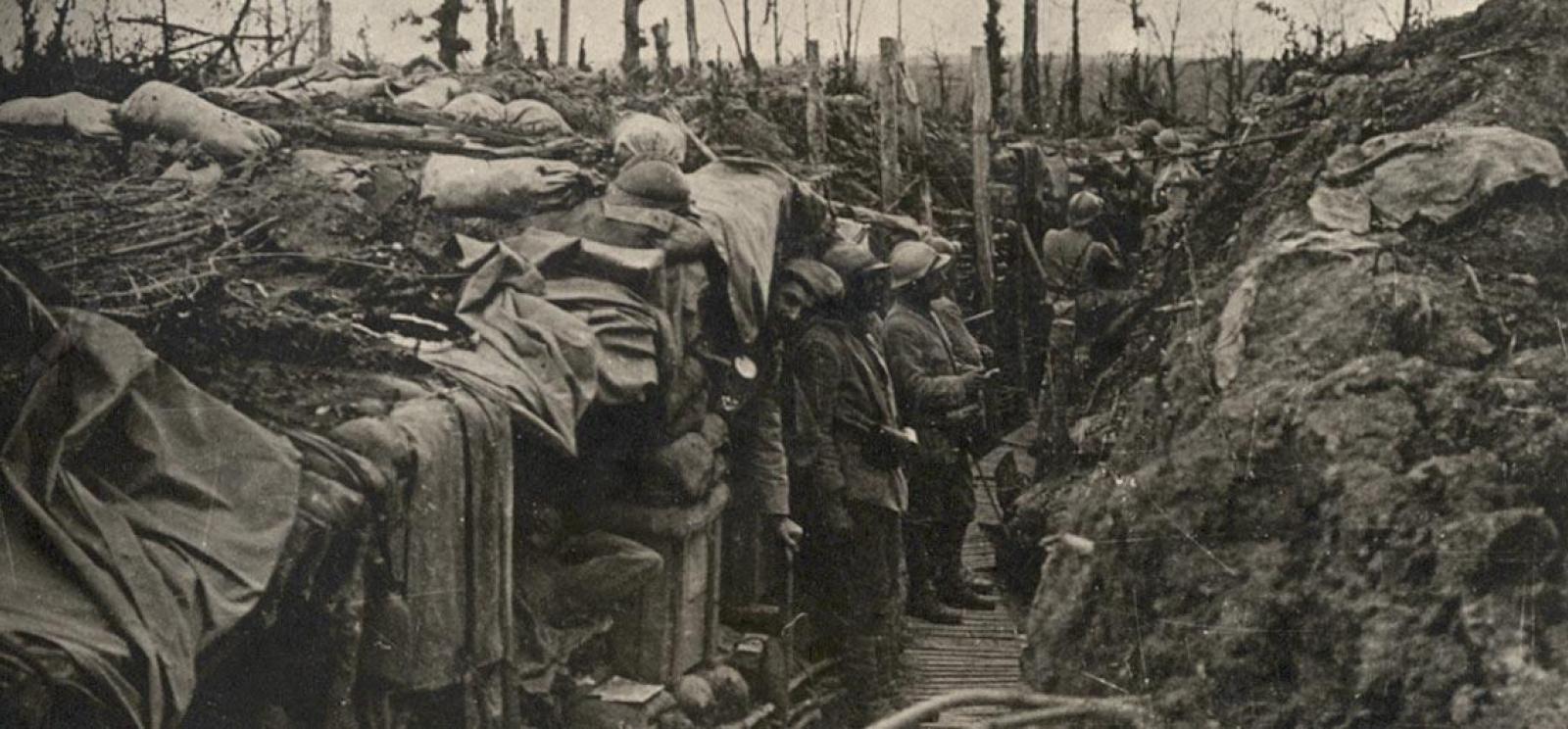
World War I was a war of trenches.
After the early war of movement in the late summer of 1914, artillery and machine guns forced the armies on the Western Front to dig trenches to protect themselves. Fighting ground to a stalemate. Over the next four years, both sides would launch attacks against the enemy’s trench lines, attacks that resulted in horrific casualties.
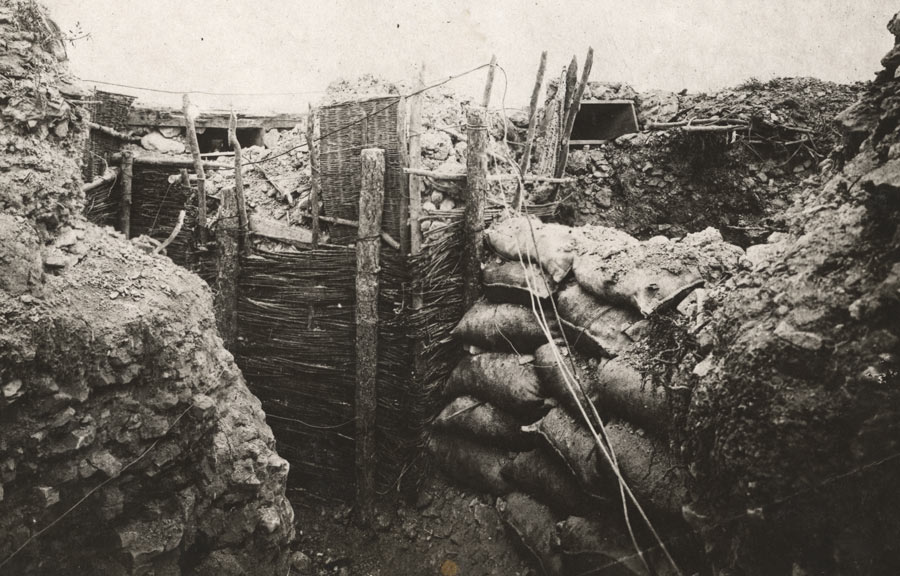
Inside a trench, all that is visible is just a few feet on either side, ending at the trench walls in front and back, with a patch of leaden sky visible above. Trenches in WWI were constructed with sandbags, wooden planks, woven sticks, tangled barbed wire or even just stinking mud.
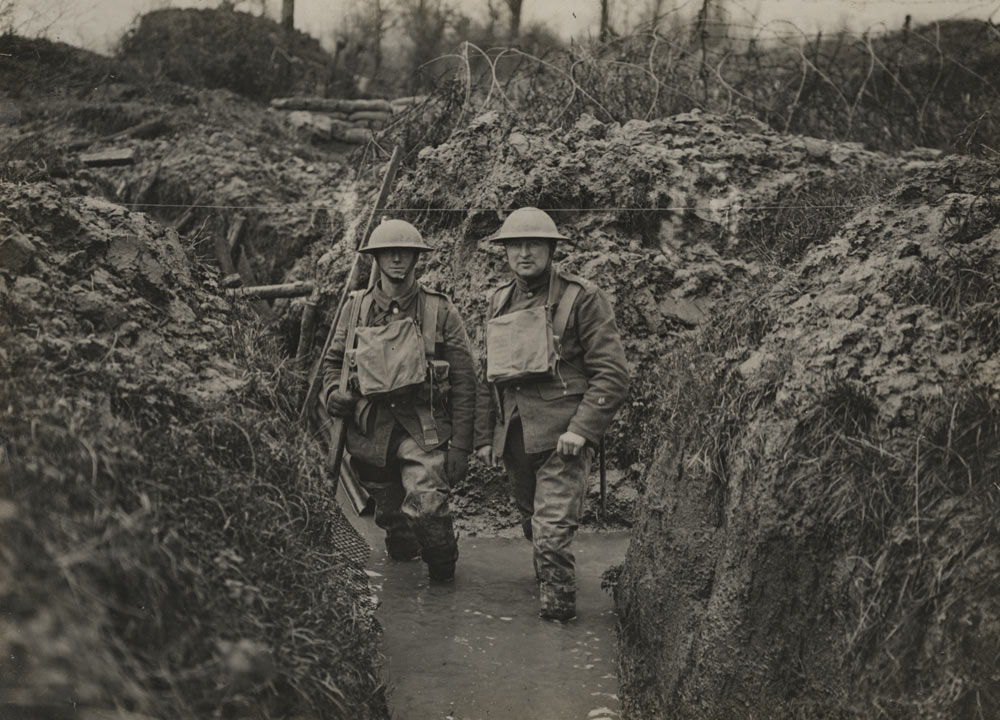
Despite the use of wooden plank ‘duckboards’ and sandbags to keep out the water, soldiers on the front lines lived mired in mud. “The mud in Belgium varies in consistency from water to about the thickness of dough ready for the oven,” one British infantry soldier wrote. The constant damp often led to a condition known as ‘trenchfoot,’ which if left untreated, could require amputation to stave off severe infection or even death.
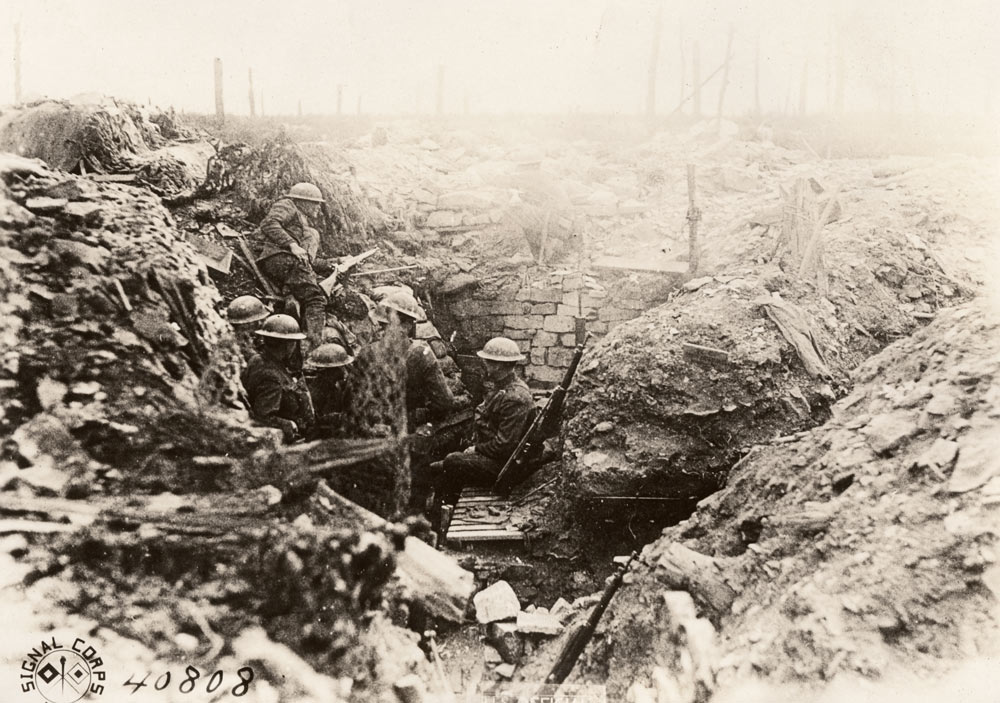
Trenches became trash dumps of the detritus of war: broken ammunition boxes, empty cartridges, torn uniforms, shattered helmets, soiled bandages, shrapnel balls, bone fragments. Trenches were also places of despair, becoming long graves when they collapsed from the weight of the war.
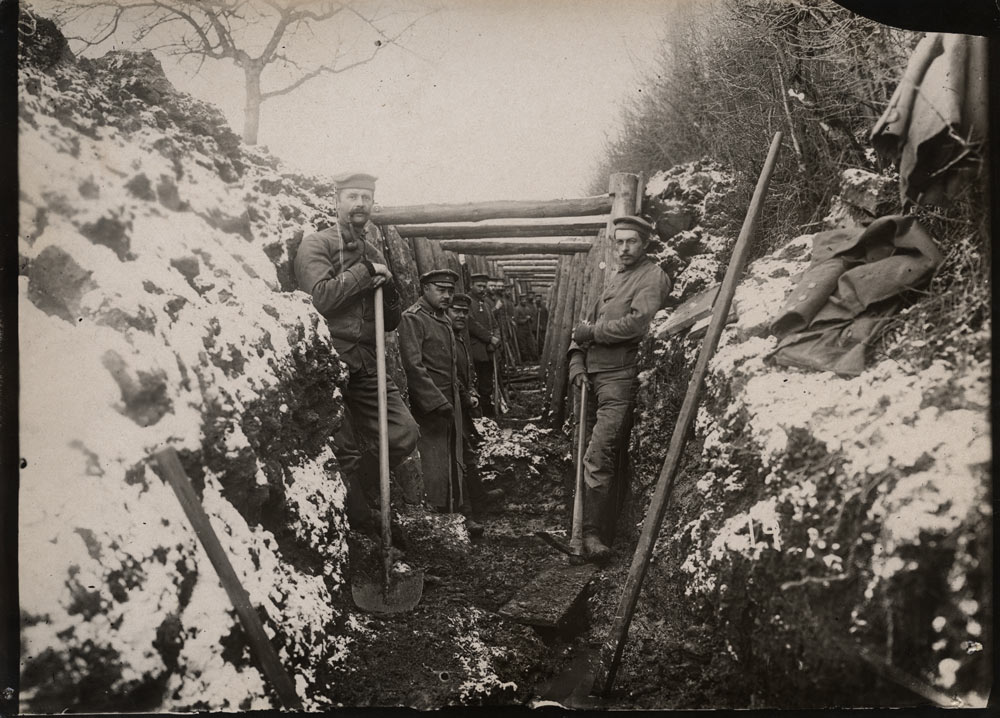
‘No-man’s land,’ was an ancient term that gained terrible new meaning during WWI. The constant bombardment of modern artillery and rapid firing of machine guns created a nightmarish wasteland between the enemies’ lines, littered with tree stumps and snarls of barbed wire. In battle, soldiers had to charge out of the trenches and across no-man’s land into a hail of bullets and shrapnel and poison gas. They were easy targets and casualties were enormously high. By the end of 1914, after just five months of fighting, the number of dead and wounded exceeded four million men.
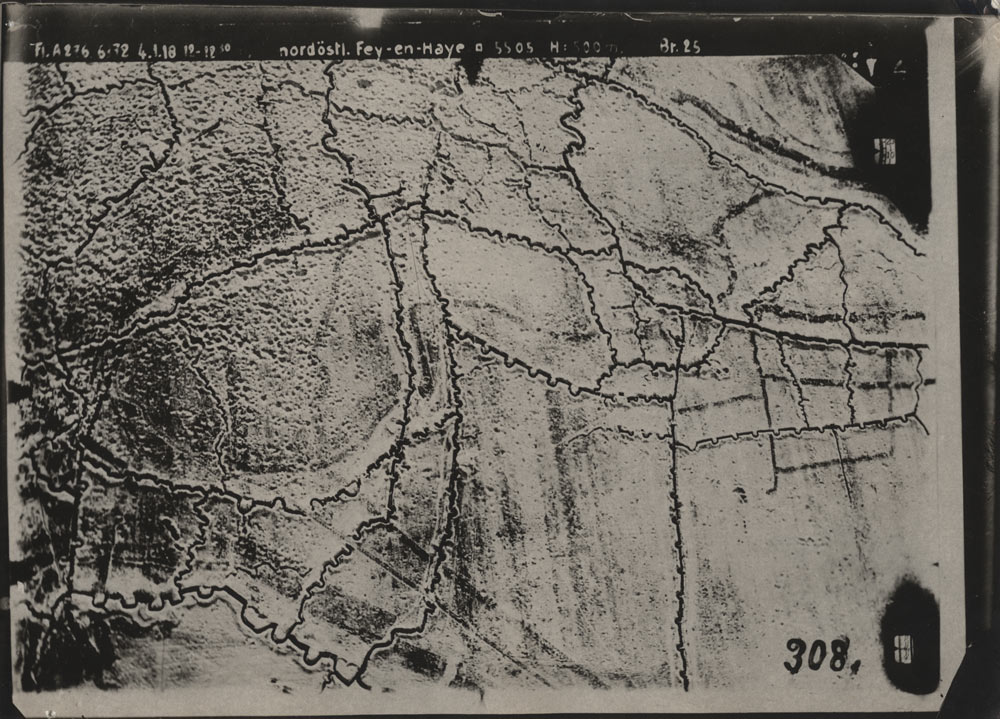
The trench systems on the Western Front were roughly 475 miles long, stretching from the English Channel to the Swiss Alps, although not in a continuous line. Though trenches offered some protection, they were still incredibly dangerous, as soldiers easily became trapped or killed because of direct hits from artillery fire.
Learn more about WWI trenches

Visiting the Somme Battlefields, a Must-Do in France
This post may contain affiliate links.
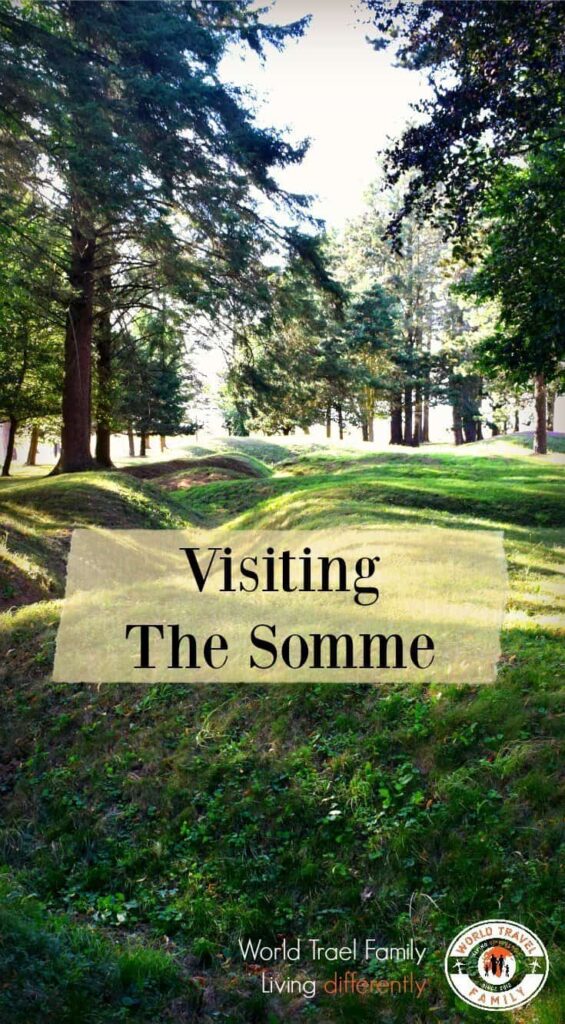
When we left our hotel just north of Paris to make our way to the ferry port at the end of our trans Europe road trip we didn’t know that our evening’s accommodation was in one of the most fascinating and historic parts of France. Not far from Amiens and our hotel, I spotted a sign for the Somme Valley. A little later a second sign for a memorial cemetery, 2 and 2 made a certainty, we were on the Somme Battlefields. Rolling fields newly harvested and quaint rural villages dotted the landscape as we took a diversion and followed the signs to the first cemetery of many in just one fascinating and memorable afternoon. The kids whined, they just wanted Wi-Fi and hotel comforts, but even they found some interest as we started touring the graves. Things got more and more interesting for them as we found craters, trenches, history, and tragedy exploring this small region of massacre.
If you’re planning on visiting the Somme Battlefields, check out the hotels in Albert, France here on Booking.com, or here on Expedia.
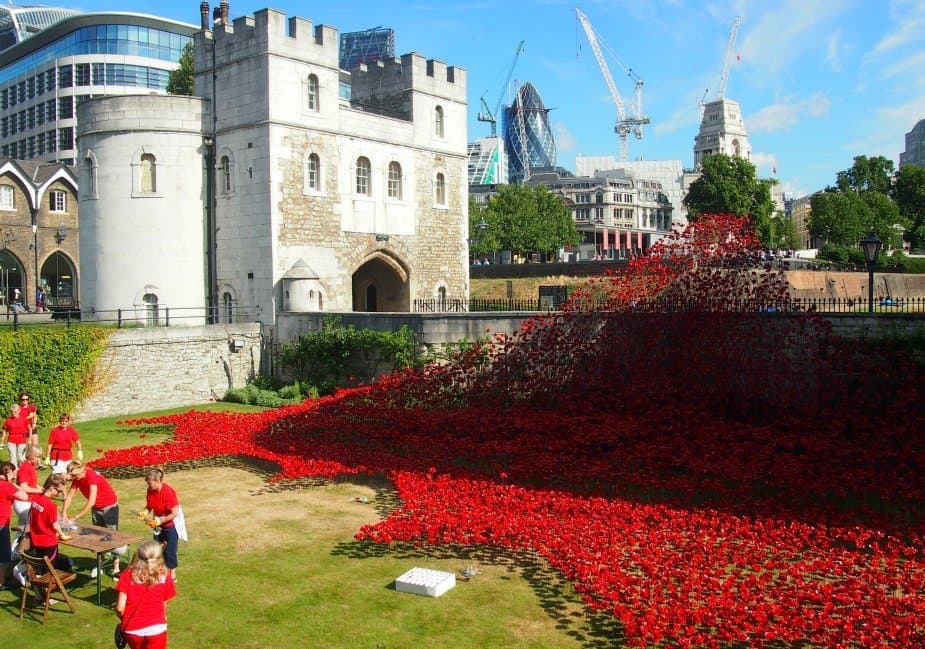
This historical period first made its way into the kids’ joint consciousness back in 2014 when we were based in London for the 100-year anniversary of World War I ‘s beginning.
Red ceramic flowers spilled from the Tower of London and towards the Thames, we read war poems online and watched dramatisations about tragic boy soldiers on the BBC. Our day on the Somme, shortly before the second round of centenary memorials added an extra layer of understanding and depth to their world schooling or homeschooling education.
There is no way anyone could learn as much from a book as by spending an afternoon on these battlefields.
This is a story of photos because that’s the best way to show you some of what’s here on the River Somme.
Photos from the Somme Battlefields, France,
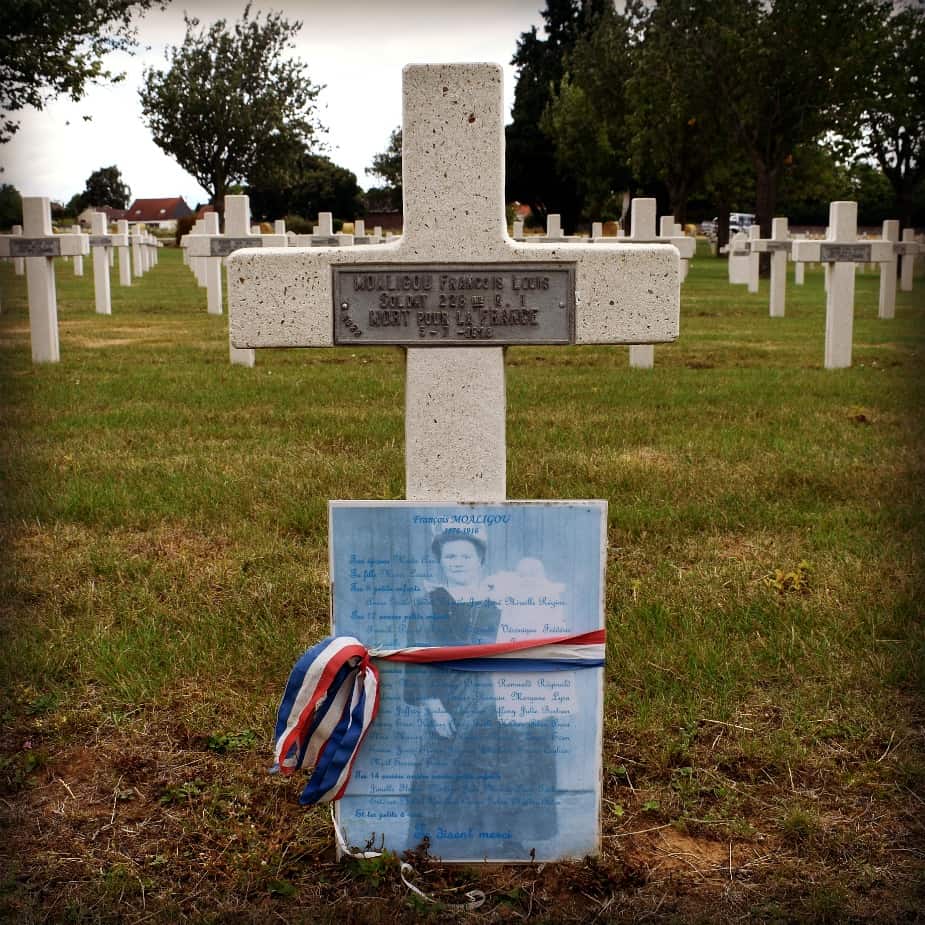
The graves and memorials of soldiers of many nationalities are prolific around The Somme Valley.
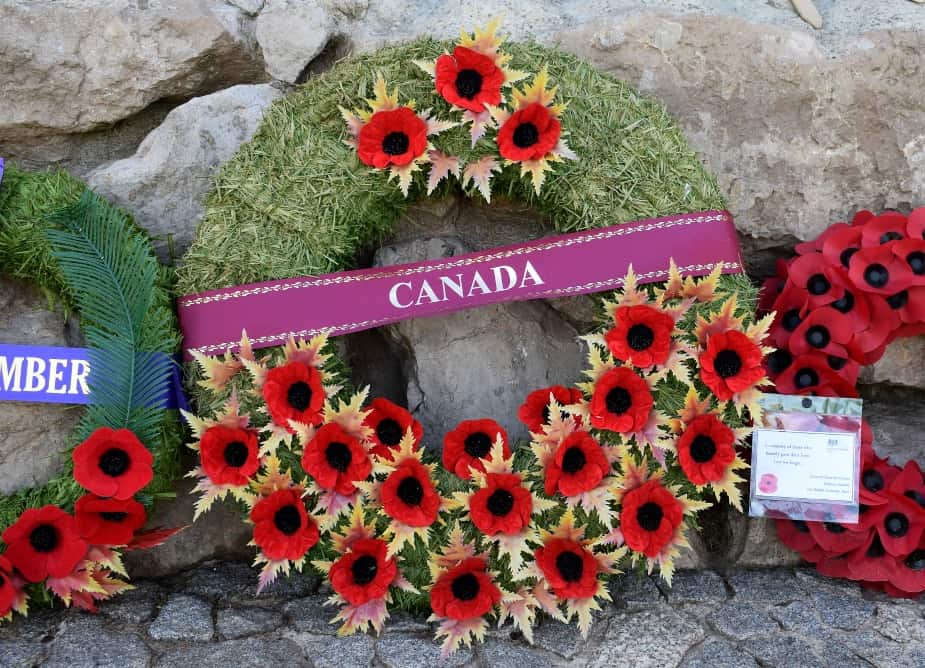
Where to Visit on The Somme Battlefields
There are many sites of interest and cemeteries in the Somme Valley. Rather than listing every destination myself, I’ll send you to this site , it’s the one we used to figure out where to go.
We highly recommend taking a car. If you want to check out our road trip costs , click-through.
Where to Stay When Visiting The Somme Region
We stayed in Amiens at the Première Classe Amiens, an ideal low-cost road trip hotel with family rooms. This region is dotted with quaint villages and moderately sized towns and cities, there are hundreds of accommodation options.
Other towns in the region that would be good bases for visiting the Somme Battlefields are Albert and Aras. Albert can normally be reached by rail via the EuroStar from Lille.
For you, for Pinterest
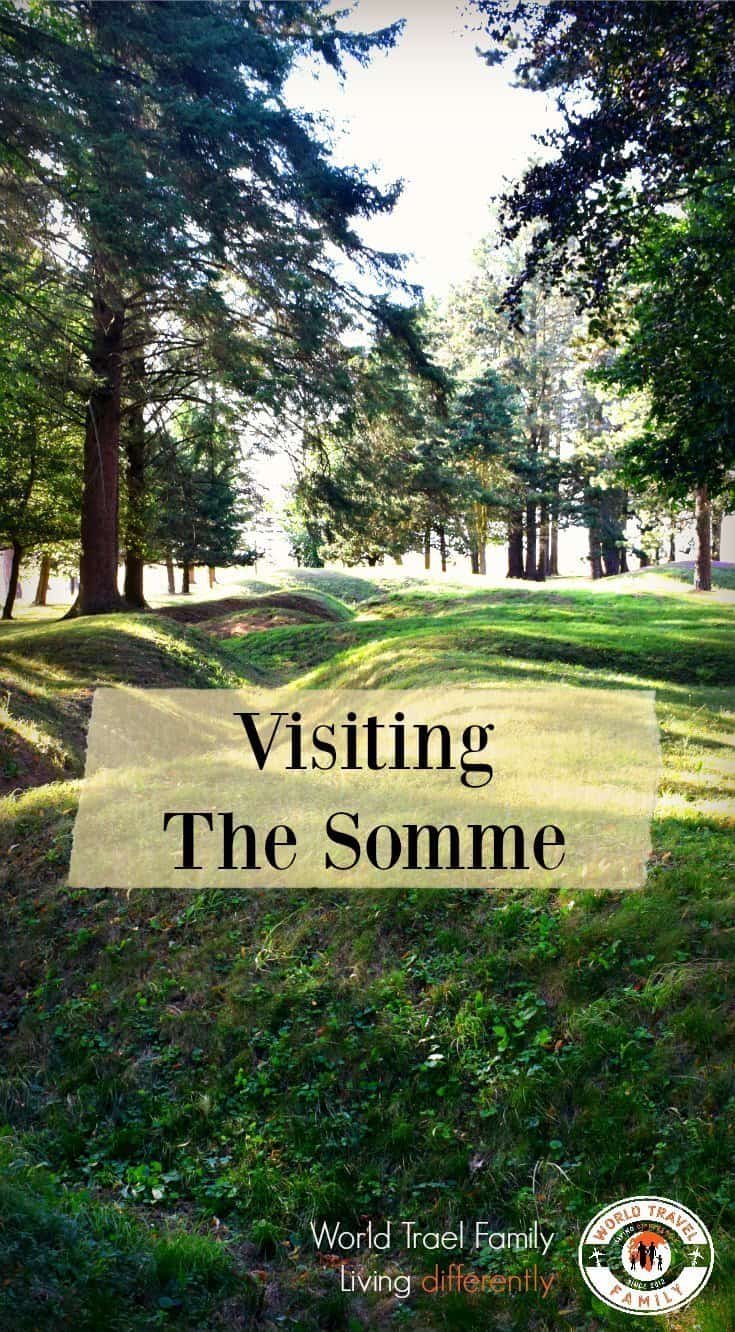
Where Are The Somme Battlefields in France?
The Somme Battlefields are in the Picardie region of France. Since 1 January 2016, Picardie (Picardy in English) has been part of the new region of Hauts-de-France which also incorporates Nord-pas-de Calais (The north, except Calais). It is located in the northern part of France and parts of historical Picardie had borders with the British Channel to the west. ( source )
Calais is the nearest major ferry port to the Picardie region and is to the north of the Somme Battlefields at a distance of about 75 miles, 120 km.
Somme Battlefields From Paris
Paris is south of the Somme Battlefields. The distance is roughly the same as from Calais, 120 Km or 75 miles. The drive time should be about 2 hours depending on traffic and exactly where you choose to go.
You can book a tour of the Somme Battlefields and region if you are staying in Paris. You can find out more and reserve your spot here.
If you’d prefer to self-drive and visit the region at your leisure, we suggest you look at Discover Cars to find the best deal. Driving in Paris is not for nervous drivers, and traffic can be terrible.
If you’re looking for a place to stay in Paris for your visit to the Somme trenches, we have a guide to the best (expensive) hotels in Paris for families , alternatively, see Paris hotels here.
Paris has the nearest airports for visiting the Somme Battlefields. If you choose not to rent a car in Paris you can take a train to Albert. Check out the hotels in Albert France here.
Where Was The Battle Of The Somme
The Battle of the Somme, or the Somme Offensive, took place in 1916 along 40 miles of the Somme River in France. The battle lasted 5 months and the number of casualties was horrific. To read more about this horrific era of history, go here.
More World War Worldschooling Coming Soon
We’re on our way to Vietnam. Another country, another war. I’m writing this from London, curled up on the sofa with a child snuggled into me on either side.
We decided to start learning about Vietnam this morning and the movie Good Morning Vietnam is their first real glimpse of the horrors that conflict brought. It’s sad, so very sad. But they have to know and they have to remember.
So on we go, to learn more about the world, that it’s fabulous and it’s tragic. I hope their generation fully learns the lessons of history so clearly presented to anyone who pays attention.
If you’re interested in the concept of worldschooling, we are the experts, you can sign up for our worldschooling newsletter. My kids were certainly inspired by history and did extremely well in their future exams.
Visiting The Somme Trenches
It was very much worth visiting the Somme Trenches and we all learned a lot from this trip. This is also a very beautiful part of France, so yes, we recommend you visit the Somme area, battlefields, and trenches. Tell me in the comments if you plan to go, and of course, I’ll answer any questions.
- Facebook 683
- Pinterest 187
If you'd like to hire a car during your stay, use this car rental comparison tool to find the best deal! We also suggest you take a look at this company to get a quote for all kinds of the more tricky adventure or extended travel insurance. Try Stayz / VRBO for an alternative way to find rentals on homes/apartments/condos in any country!
Related Posts:

Alyson Long
Europe road trip costs, best travel towels, which travel towel to buy, 7 thoughts on “visiting the somme battlefields, a must-do in france”.
Behind which cafe did you find the restored trenches?
There’s a link in the post to a site with maps and full information Cathy.
For anyone else wondering where this cafe was, I believe it may be this one:
Le Tommy 91 Route d’Albert, 80300 Pozières, France
Great site btw Alyson! Makes me want to pack our bags now as we sit in a foggy Somme valley!
Maybe, I can’t remember, but it’s on the website I linked to. Thanks very much!
My Dad is a Vietnam Vet. While he didn’t lose his life there, he indeed left it there. When he came back, under 20 years old and stricken with SEVERE PTSD that would go undiagnosed for 25 years. By the time it was he had already ruined his marriage, his children childhoods and wifes life — not to mention his own. It took him jumping out of a 5 story window int he midst of a flash back in front of my 17 year old brother for them to start taking notice. By then it was far too late. He died last year, just a few months past his 65th birthday. He moved in with me the last 6months, he stopped recognizing me but never forgot me — he would talk bout me not realizing it was me he was talking to. He ended up in diapers, I would bathe him in he middle of the night when he would have bowel movements, bells on his bed so I could hear when he would try o get out of bd as his mind was much stronger than his body. The war took everything form him — the military used him up in his youngest years – his strongest years and threw him away like garbage thereafter. IDK if there are a group of veterans more mistreated then those of Vietnam.
What a tragic story Stephanie.
I would definitely like to see this, some day!
Leave a comment Cancel reply
Save my name, email, and website in this browser for the next time I comment.
Visit The Somme and the WW1 Battlefields of The Western Front...

SUPPORTING WW1 BATTLEGROUND
HISTORY AND PRESERVATION

FRONTS LINES AND TRENCHES
Your one stop portal for visiting the somme and western front battlefields. .

AERIAL PHOTO OVERLAYS
Original aerial photographs overlaid on to the land as it is today.

BATTLEGROUNDS
Original and modern battleground maps overlai d on to the land as it is today.

OBLIQUE AERIAL PHOTOS
Original oblique aerial photographs.

Original section panoramas of many battlegrounds on the Western Front.

COMMENTS & FEEDBACK
A big "thumbs up" for the latest publication on Bullecourt! My relative Bert Perry was awarded his MM there during fighting with D Coy of 14th Bn AIF.
I have been to Bullecourt before to try and find exactly where he would have crossed no mans land, but Paul's work will help me to really walk in his footsteps when I go next. Definitely recommended!
Gil (Frontaal Tours)
‘Fronts Lines and Trenches’, project Beaumont-Hamel. by Paul Humphriss. This booklet delivers exactly what it promises: front lines and trenches. Dozens of aerial photos "then and now" superimposed, and also some beautiful panoramas. Nowadays there is a lot to be found online, but I think paper still offers great added value.
I have looked at your site many times and am a great admirer of all that you do. It is excellent, superbly professional and endlessly fascinating - and a major resource for so many people and hugely appreciated by many.
You’re doing a brilliant job in keeping the memory alive in an innovative and unique way.
Paul, thank you very much once again. I will make the trip Belgium next June. You FB page here is of the best calibre, and i enjoy reading and learning from all the information that comes across here.
Well done Paul! You are so kind. I will never forget you locating my great uncle, William Quade AIF.
This is an amazing series/sequence of photos, Paul Humphriss. How clearly they evidence the effects on the terrain of a prolonged battle.
Have you thought about offering them to schools for WW1 syllabus?
Truly amazing piece of work. We are indebted to you.
Just received my copy, wow, the work and effort is to be applauded, this will be forever in my bag when on the Somme, this will help to understand the areas and actions better and pinpoint trenches.
Brilliant research Paul. Congratulations! Private Angus Munro, Rest in Peace, in the warm glow of glory. You’re not forgotten.
He is an ace at this kind of thing. He has done the same for me for the locations of the deaths of two of my Great Uncles; one in the Second Battle of Ypres and one just outside Courcelette. Jim.
Would just like to thank Paul at ‘Fronts,Lines and Trenches’ for providing me with a number of battle maps and overlays of areas where my Great Grandfather served at Arras. After sending Paul names of trenches which were named in the War diary he produced not only original trench maps but he also placed them over current terrain maps to see exactly where the position was. The work he put in was so much appreciated and when I visit in September (COVID-19 permitting) these will be of great assistance to stand where my Grandfather did.
After making a donation to the up keep his work I also purchased one of his T-shirt’s which arrived today. Great quality and fantastic service on this page. If anyone is looking for assistance then I would highly recommend Paul’s work.
Visit The Somme and the WW1 Battlefields of The Western Front, WW1 Photographs, Somme Hotels, B&B's, Cemeteries, Museums, Memorials, Battlefield Maps and Battlefield Tours.
Premium Content

World War I soldiers created underground art in the trenches.
Trapped in beneath the ground by trench warfare, the soldiers of the Great War left their mark in subterranean works of art.
The entrance is a wet hole in the earth little bigger than an animal burrow, obscured by thorny brush in a secluded wood in northeastern France. I’m following Jeff Gusky, a photographer and physician from Texas who has explored dozens of underground spaces like this one. Together we slither through the muddy hole into the darkness below. Soon the passage opens up, and we crawl forward on hands and knees. The glow from our headlamps wavers along the dusty chalk walls of the century-old tunnel, which slopes away from us down into the shadows. After a few hundred feet the tunnel ends at a little cubicle hewed out of the chalk, reminiscent of a telephone booth.
Here, shortly after the outbreak of the First World War—which began a hundred years ago this summer—German military engineers would take turns sitting in total silence, listening intently for the slightest sound of enemy tunnelers. Muffled voices or the scraping of shovels meant that a hostile mining team might be only yards away, digging an attack tunnel straight toward you. The danger grew if the digging stopped and you heard the sound of bags or cans being quietly stacked, one on top of another. It signaled that the enemy was laying high explosives at the end of the tunnel. Most nerve-racking of all was the silence that followed. At any moment the charges might detonate and blow you apart or bury you alive. ( See how World War I energized mapmaking at National Geographic. )

Nearby, on one of the tunnel walls, our headlamps illuminate graffiti left by the German engineers who manned this listening post. Their inscribed names and regiments are crowned by a motto: “ Gott für Kaiser! (God for the Kaiser!).” The pencil marks appear fresh, as if they were written yesterday. In fact, the soft chalk and limestone bedrock of France’s Picardy region was ideal not only for mining operations but also for World War I soldiers to record their presence in penciled signatures, sketches and caricatures, carvings, and even intricate relief sculptures. This underground art is relatively unknown beyond a circle of World War I scholars and enthusiasts, as well as village mayors and landowners, many of whom Gusky has spent years getting to know.
His images bring to light the subterranean world soldiers endured while sheltering from constant shellfire. They left names, images of women, religious symbols, cartoons, and more. These traces, Gusky says, illuminate a forgotten world of World War I, connecting us to the individual soldiers, many of whom would not survive the nightmare of trench warfare.
The conflict began with mounted cavalry and confidence on all sides that it would all be over by Christmas. By the end of 1914 the German advance had stalled, the armies had dug in, and an extensive network of trenches stretched from the North Sea coast to the Swiss border. An arms race led to the first mass use of poison gas, air warfare, and tanks. On the western front, millions of troops died in largely futile offensives and counterattacks. ( National Geographic's guide to the sites along Europe's Western Front. )

In the grip of this deadly stalemate, the Germans and their French and British adversaries resorted to siege-warfare techniques that had changed little over the centuries. The goal was to dig under key enemy strongpoints and blow them up; counterattacks were thwarted by setting off charges to destroy their own tunnels. At the height of the underground war, in 1916, British tunneling units detonated some 750 mines along their hundred-mile sector of the front; the Germans responded with nearly 700 charges of their own. Hills and ridges that provided vital lookout points became riddled like Swiss cheese, while the biggest mines blew out huge craters that still scar the landscape to this day. Even a single small mine could wreak havoc: In the tunnel complex we crawled into, a charge set off by the Germans on January 26, 1915, killed 26 French infantrymen and wounded 22 more.
But the underground war was not confined to narrow tunnels. Beneath Picardy’s fields and forests are centuries-old abandoned quarries, some of which could shelter thousands of troops. On a misty morning we explore one such site, located along a cliff edge overlooking the Aisne Valley. We’re led there by the owner of the ancestral property, which we agree not to name to protect the quarry from vandals.

He proudly shows us a monumental carving of Marianne, the classic French symbol of liberty, guarding the entrance to the quarry. Beyond, in the gloom of the man-made cavern, we peer at an array of finely engraved badges and memorials proclaiming the French regiments that had sheltered here. And we come upon several chapels elaborately carved and painted with religious symbols, army insignia, and the names of notable French victories. The landowner shows us a stone stairway that led from one of the chapels to the fury of exploding shells and machine-gun fire in the front lines above. “My heart stirs when I think of all the men who climbed these steps and never came back,” he says.
Life in the quarries was vastly preferable to the muddy hell of the trenches above. A journalist visiting one of the caverns in 1915 noted that “a dry shelter, straw, some furniture, a fire, are great luxuries for those returning from the trenches.” They kept an even temperature year-round, but as one French soldier wrote home, “vermin devour us, and it’s teeming with lice, fleas, rats and mice. What’s more, it’s very humid and a lot of the men fall sick.” To pass the time, the exhausted men would daydream. Images of women proliferate on the quarry walls, including many sentimental and idealized portraits.
Both sides converted the largest quarries into underground cities, many of them remarkably intact today. Not far from the landowner’s property, we hike across the potato fields of a farm owned by his cousin. A young man in his 20s, he had reclaimed the land by personally collecting dozens of unexploded mortars, grenades, and shells, some containing still lethal poison gas, which the army took away and detonated.

Beneath his potato field, we find ourselves in an astonishing labyrinth, a medieval quarry that stretches for more than seven miles, with twisting passageways and high ceilings reminiscent of a subway station. In 1915 the Germans connected this vast warren to their frontline trenches. They installed electric lights and telephones, command posts, a bakery and butcher’s, a machine shop, a hospital, and a chapel. Although thick with rust, the original diesel generator and barbed wire defenses are still in place. So are dozens of street signs neatly stenciled on every corner, essential reference points in the disorienting maze of passages. On the cavern walls German troops have inscribed their names and regiments, religious and military icons, elaborately sculpted portraits and caricatures, and sketches of dogs and other cartoons. ( Learn about important part animals played in World War I. )
You May Also Like

100 years ago, the United States enters World War I

See how ancient Indigenous artists left their mark on the landscape

The Christmas Truce of 1914: What historians say really happened
Among the most prolific decorators of the underground cities was the 26th “Yankee” Division, one of the first U.S. units to reach the front following America’s entry into the war in April 1917. To visit the quarry where they were billeted at Chemin des Dames, we climb down two wobbly ladders into a cavern 30 feet below. We spend hours exploring a hundred-acre complex. Our headlamps reveal an extraordinary time capsule of the war: passageways strewn with countless bottles, shoes, shell cases, helmets, beds made of rusted chicken wire, even an entire cooking range with pots and pans still in place.
For six weeks beginning in February 1918, these passages were filled with the sounds and smells of hundreds of American men. Mostly raw recruits, they were rotated in and out of the quarries to their first experience in the trenches above. The men spent hours decorating every square inch of certain walls. We pick out dozens of religious and patriotic symbols: insignia of the Freemasons and Knights of Columbus; portraits of Uncle Sam, Buffalo Bill; and caricatures of the kaiser. Among the penciled names my eye falls on is “Earle W. Madeley,” a corporal from Connecticut who notes he is “aged 20 years.” Records show Madeley was killed on July 21, 1918, one of 2,000 deaths inflicted on the Yankee Division before the November armistice.

Safe underground from the inhuman chaos of the battlefield above, the men of the First World War left these personal expressions of identity and survival. But this unique heritage from the war is under threat. When vandals tried to saw off the image of Marianne, the outraged landowner fitted metal bars on all of his quarries. At the Yankee Division quarry, a retired auto mechanic dedicated to safeguarding it built hefty metal gates and installed padlocks. But many other sites remain at risk from vandals and thieves.
The auto mechanic secures the lock, and we walk back to the car. As the bitter January wind blows across the battlefield, I ask him why a quarry filled with American names is so important to him. He reflects for a second, then replies, “By reading the names of the men down there, we make them live again, for a moment.”
Related Topics
- WORLD WAR I
- UNDERGROUND EXPLORATION
- PHOTOGRAPHY
- HISTORY AND CIVILIZATION

Poisoned, shot, or drowned? Here’s how Rasputin really died.

They were seeking a mythical oasis. They found a Stone Age surprise instead

Has the U.S. ever fought on Russian soil? You’d be surprised.

This 'workaholic' emperor was hiding a tumultuous private life

These prehistoric ‘baby hands’ are not what you think
- Environment
- Perpetual Planet
- History & Culture
History & Culture
- History Magazine
- Mind, Body, Wonder
- Terms of Use
- Privacy Policy
- Your US State Privacy Rights
- Children's Online Privacy Policy
- Interest-Based Ads
- About Nielsen Measurement
- Do Not Sell or Share My Personal Information
- Nat Geo Home
- Attend a Live Event
- Book a Trip
- Inspire Your Kids
- Shop Nat Geo
- Visit the D.C. Museum
- Learn About Our Impact
- Support Our Mission
- Advertise With Us
- Customer Service
- Renew Subscription
- Manage Your Subscription
- Work at Nat Geo
- Sign Up for Our Newsletters
- Contribute to Protect the Planet
Copyright © 1996-2015 National Geographic Society Copyright © 2015-2024 National Geographic Partners, LLC. All rights reserved
guidedbattlefieldtours.co.uk

World War 1 Tours – Trenches
Our guests often ask us if it is possible to see World War 1 trenches on our battlefield tours. We visit a number of fascinating sites where you can see preserved trenches. Archaeologists have excavated a section of British front line trench in Thiepval Wood which was used on the first day of The Battle of the Somme and to visit these, see the artefacts found in them and hear the stories of soldiers who fought there is a real highlight of our tours. Also on the Somme we see the preserved trenches in Newfoundland Park. The whole battlefield was preserved after World War 1 and both the British and German trenches are clearly visible on the ground, as is no man’s land in between, pockmarked with shell holes. We also see both of these sites on our Treading in Tommy’s Footsteps and Recalling the Somme tours.

Excavated trenches Thiepval Wood
Hooge at Ypres was one of the most feared and fought over places on the Western Front and a highly atmospheric section of British trenches has been excavated here. This was the site of the first flamethrower attack and not only includes trenches, but also a series of mine craters and a concrete bunker which our guests enjoy exploring. At Yorkshire trench, archaeologists discovered a major British underground bunker system. These trenches were used during The Third Battle of Ypres (The Battle of Passchendaele) and are another site which our guests never fail to find of great interest. We visit these sites on our Chapters from the Western Front and Ypres Remembered tours.

Preserved Trenches at Hooge
Another site at which both British and German trenches have been preserved is at Vimy. As at Newfoundland Park, a section of the battlefield was preserved after World War 1. The whole area is scarred by gigantic mine craters, shell holes and trench lines. Our guests are always amazed by just how close together the opposing trenches could be. We visit Vimy on our Battles of 1917- 1918 tour. Another set of trenches which our guests never fail to find fascinating and which we also visit on our Battles of 1917- 1918 tour are the German trenches at Bayernwald. Overlooking the British lines on the Messines Ridge, this trench system includes the entrance to a German mine shaft and a series of concrete bunkers.

German bunkers at Bayernwald
None of the preserved trenches can accurately portray the realities of World War 1, but visiting them is a fascinating experience which definitely helps the visitor to understand the war more fully and help bring the battlefields to life.
Some Recent Testimonials
Mr w, sheffield 2019.
“The tour pack was a magnificent piece of work. A fantastic and very busy schedule, which wouldn’t have been possible
Read More »
Mr H, Lichfield 2018
“Exceptional. The knowledge and personal stories made the tour feel very human rather than just dry history.”
Mr T. Northampton 2017
“Outstanding. Nothing seemed too much trouble.”

Centre for Experimental Military Archeology

It's Time for a Historical Adventure!
Welcome to CEMA
CEMA is the home of historical experimentation, focused on military attack and defence over the ages. From the Roman period to the Second World War, we aim explore soldiers’ day-to-day lives through practical experimentation.
Our first project was to build a replica WWI trench system based on Railway Wood, Ypres, which is currently open to the public at the Kent Showground. The site itself has a rich military heritage with more than 2000 years of history that we aim to uncover!
CEMA works in collaboration with the University of Kent and Wessex Archaeology to provide research and educational experiences for schools, army recruits and fellow historians. We are also available to hire for private groups and film production organisations.
Our Services

School Visits
Private Groups

Hire for Film & Media

Home Educators
"The CEMA experience is a fantastic one. We have been visiting for 2 years running now - taking in excess of 100 students both times - and we intend on making it a permanent feature of our Year 10 Curriculum . It reinforces so much of what is covered for the Western Front unit in the Medicine Through Time paper with the talk on the chain of evacuation being a particular strength for this. The other talks and the trench provide invaluable context for the war. All guides are incredibly knowledgeable and passionate which helps the students really engage with the subject matter. Lastly, the mock trench, set amongst atmospheric woodland, is not only a brilliant replica but really helps students to understand how unprecedented this war was. Our school would highly recommend this!"
Rocky Haines
Highworth Grammar School, Ashford

Work with us
CEMA is looking for enthusiastic volunteers and donations to help us maintain our current projects and to help build future ones!
Letters Home - A short film by The Royal Navy for Remembrance 2022. Filmed partly on location at our trench.
We are based at the Kent Show Ground
(Detling, Maidstone ME14 3JF)
on the A249, just off the M2 and M20.
CEMA Detling Hill, Maidstone ME14 3JF England
+447771 993 001
Thank you for submitting!

IMAGES
VIDEO
COMMENTS
Beaumont-Hamel Newfoundland Memorial, Beaumont-Hamel, France Wikimedia Creative Commons. Among the trenches that make up this network constructed in a pocket of northern France, located about 100 ...
The fields of Northern France and Belgium still bear many of the scars of last century's Great War, but they are a faint reminder of battle carnage on the Western Front. After the Armistice ...
Arras - Arras, one of the great cities of Northern France, was the site of two major battles in 1914 and 1917. The CWGC Visitor Centre is close to Arras - a must-visit for any trip to French WW1 battle sites. Cambrai - Cambrai is notable for being the site of the first major tank battle in history.
In the early days of World War One, the German Army advanced into Belgium and Luxembourg, creating the Western Front - a 400-mile-long stretch of land from France's Swiss border to the North Sea that would go on to host some of the most brutal theatres of conflict in World War One, if not all of history.. Characterised by trench warfare, in which pockets of land were fought over for weeks ...
Share us your most beautiful shots and find them live in our social networks! #GoSomme. 12°/1°. Out at sea01h229.48m. Low tide08h281.48m. Out at sea13h389.43m. Low tide20h431.53m. Guided visits and Battlefields tours of the Western Front in the Somme. Visiting the WW1 Somme Battlefields in Northern France is a must for everyone.
Here are some of the original trenches that remain for you to experience on one of my First World War battlefield tours. Beaumont Hamel, Somme, France. The Newfoundland Memorial Park on the Somme is perhaps one of the most visited sites anywhere on the Western Front. This is probably because visitors can get a feel of how the battle unfolded ...
Visiting the WW1 Western Front Battlefields. One of the very few sites where original trenches dating from 1914-1918 have been preserved at the Hill 62 Sanctuary Wood museum, Ypres Salient, Belgium. The 1WW battlefields of the Western Front are located in a long line of approximately 450 miles from the Belgian coast, through the southern ...
Trenches of WWI. An Immersive Tour. Online. Enter the Exhibition. One of the most common images associated with World War I is the trench. View this narrated, immersive tour of the Museum's trench displays on Google Arts & Culture and learn the history of trench warfare on the Western Front. ENTER EXHIBITION.
Visit 'La Main de Massiges,' the Hand of Massiges a high point where the Germans retreated in 1914. It's here that the Champagne and Argonne fronts meet. Though the Champagne area of France has soil well suited for growing grapes for Champagne, this chalky soil, when dug out to build trenches, floods easily, making for impossible conditions.
Visit a WW1 Grave or Memorial. Visiting a grave at Guillemont Military Cemetery on the 1916 Somme battlefield. An interest for many people wanting to visit the battlefields is the discovery of a relative who fought on the Western Front. In many cases tracing the war service of a relative leads to the knowledge that that the person was killed in ...
Visit Google Arts and Culture to learn more. Explore several model WWI trenches and understand the history of trench warfare with this narrated, immersive online tour. The tour can also be viewed as a VR experience using Google Cardboard-compatible device. Visit Google Arts and Culture to learn more.
Sanctuary Wood is the site of the Hill 62 Museum, with preserved trenches. This is one of the most visited Great War sites in Flanders, and gives some idea of what life in the trenches was like. Also nearby is Sanctuary Wood Cemetery and the Canadian Memorial ... The museum located here is a very popular visit on school battlefield trips. One ...
Trenches were common throughout the Western Front. Trench warfare in World War I was employed primarily on the Western Front, an area of northern France and Belgium that saw combat between German ...
This is the first in a new series of itineraries for self-driving tours from Vicarious Media. The tour includes travel visiting historical locations for the First and Second World Wars, taking in five cities across France, Belgium, Germany and the Netherlands. The tour is suitable for motorbikes, cars, motorhomes and campervans.
Helping you to make the most of your battlefield visit is the main purpose of this website. There are many more pages on what to see in the two main areas of interest on the Western Front, Ypres/Flanders and the Somme. For Flanders, these include Tyne Cot, the Menin Gate in Ypres and Passchendaele, whilst in the Somme, there are pages on the ...
Trench Warfare. Life in the Trenches, 1914-1919. World War I was a war of trenches. After the early war of movement in the late summer of 1914, artillery and machine guns forced the armies on the Western Front to dig trenches to protect themselves. Fighting ground to a stalemate.
Visiting The Somme Trenches. It was very much worth visiting the Somme Trenches and we all learned a lot from this trip. This is also a very beautiful part of France, so yes, we recommend you visit the Somme area, battlefields, and trenches. Tell me in the comments if you plan to go, and of course, I'll answer any questions.
With the Fronts lines and Trenches portal you will find places to visit on The Somme, Hotels, B&B's, Cemeteries, Museums, Memorials and Battlefield Tours. The best way to visit ww1 Battlefields. A portal for all WW1 enthusiasts and like minded whom want to visit The Somme and Western Front battlefields, WW1 photographs and Somme Hotels, B&B's ...
Trapped in beneath the ground by trench warfare, the soldiers of the Great War left their mark in subterranean works of art. ... Travel. Spend a night at the museum at these 7 spots around the world.
The Somme. The Battle of the Somme was one of the First World War's bloodiest battles. British and French armies fought the Germans for control on both sides of the Somme River, making the Somme Battlefields in France a key historical spot. In 1916 the British and French army began an offensive on the German Empire.
As at Newfoundland Park, a section of the battlefield was preserved after World War 1. The whole area is scarred by gigantic mine craters, shell holes and trench lines. Our guests are always amazed by just how close together the opposing trenches could be. We visit Vimy on our Battles of 1917- 1918 tour.
For added authenticity, visit on a rainy day and experience just how quickly the trenches become sodden with mud and water. Another location to visit on a Ypres battlefields tour would be the Yorkshire Trench. Just take a short drive north of Ypres to the village of Boezinge to find it. Yorkshire Trench was a British dugout during the war.
Visit the Centre of Experimental Archaeology in the Kent Country Show Ground for a fully immersive historical experience featuring a historically accurate World War 1 trench. A perfect location for educational school trips and film.